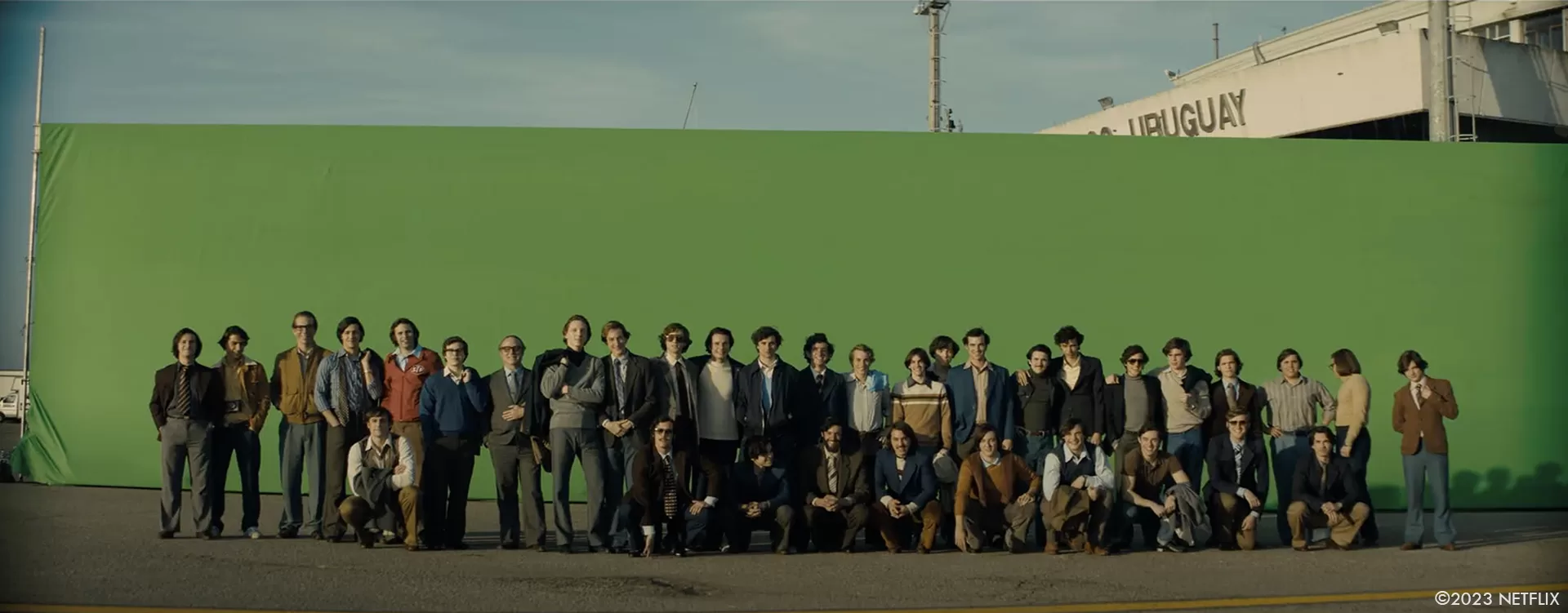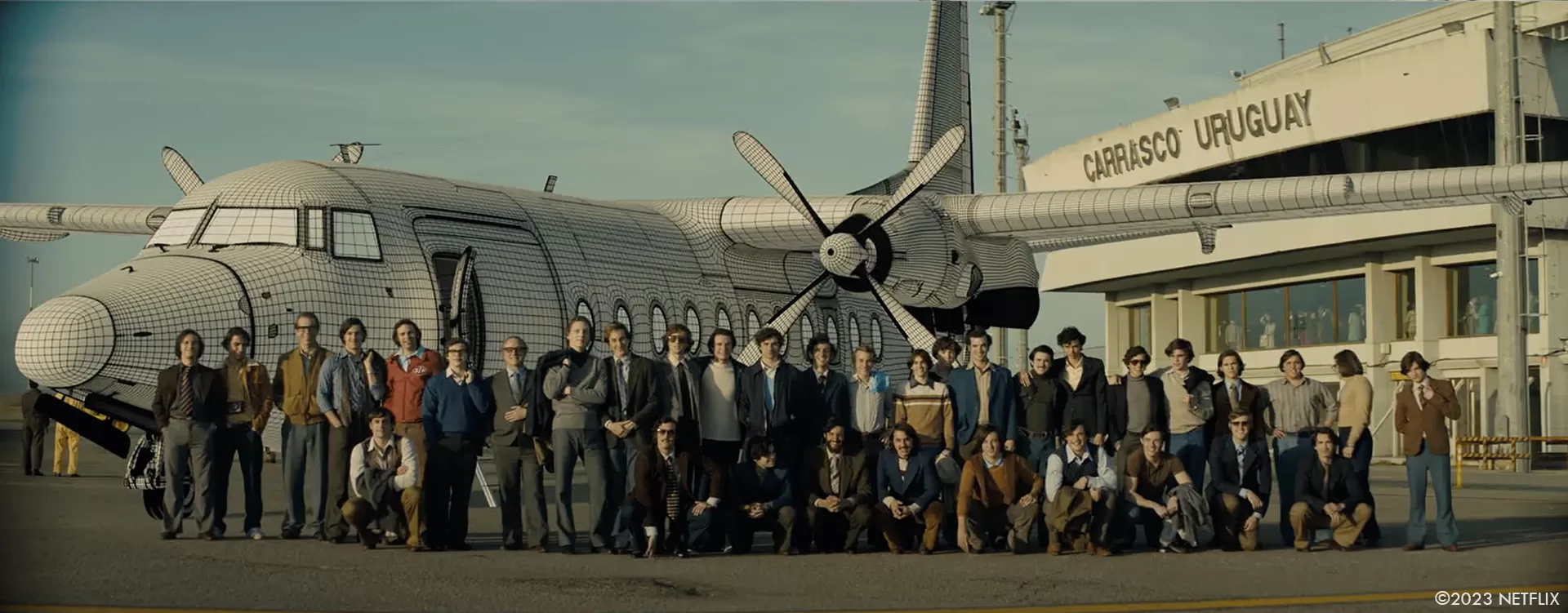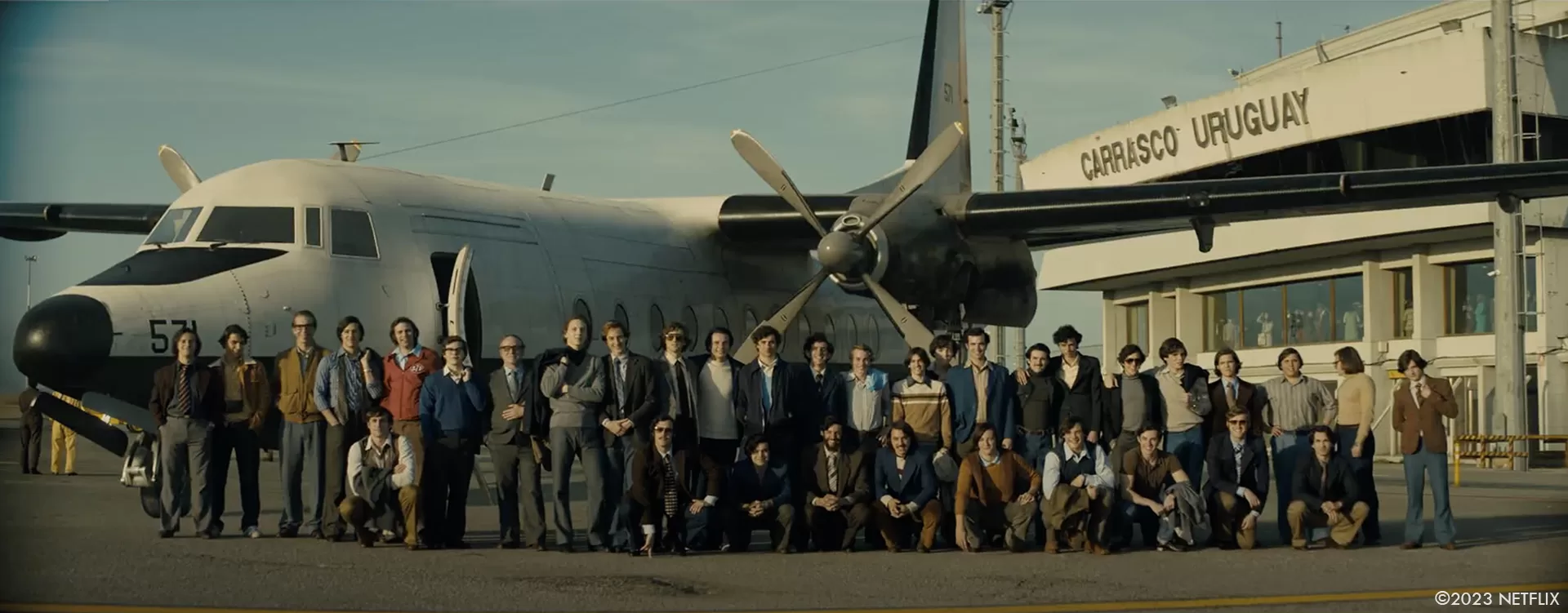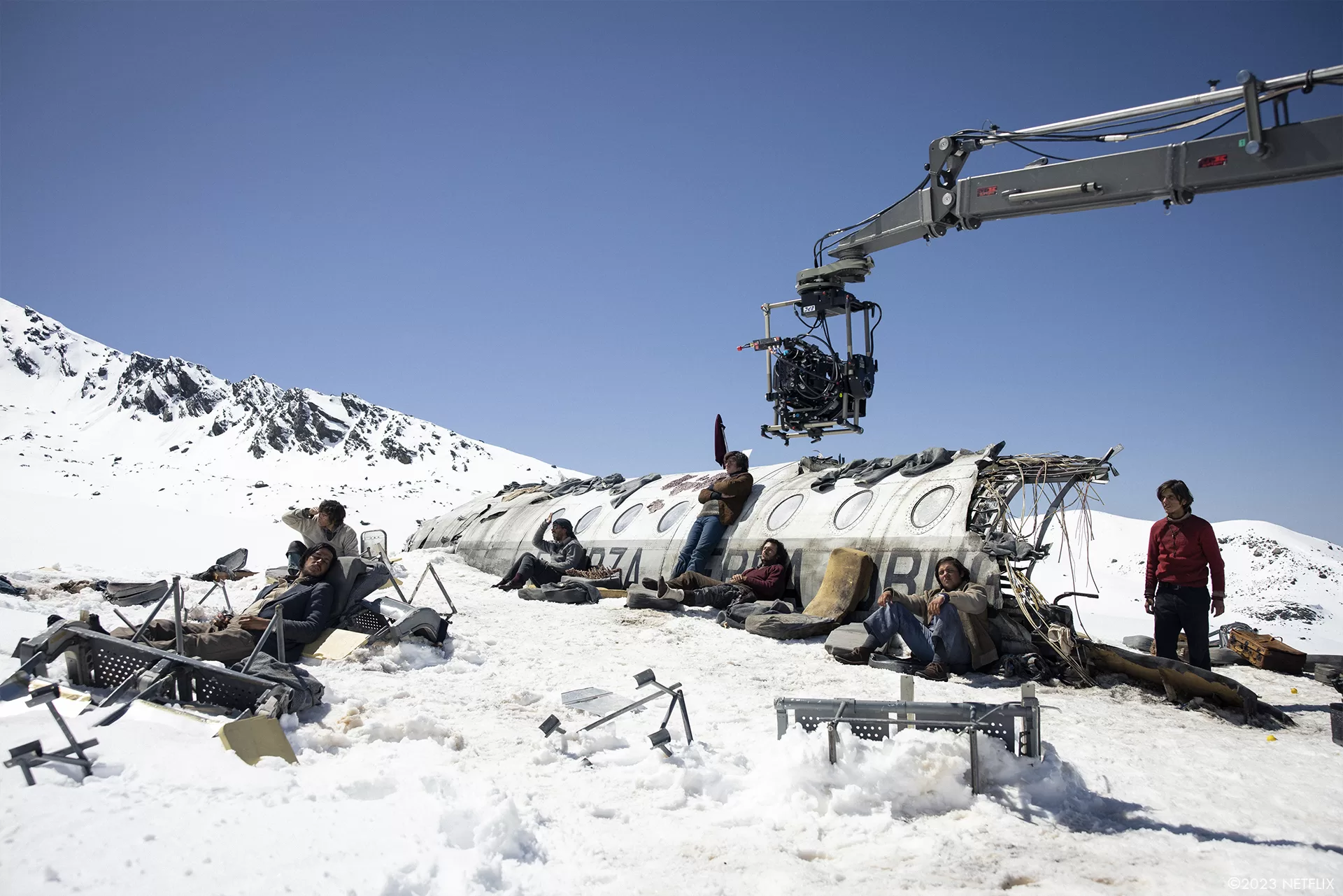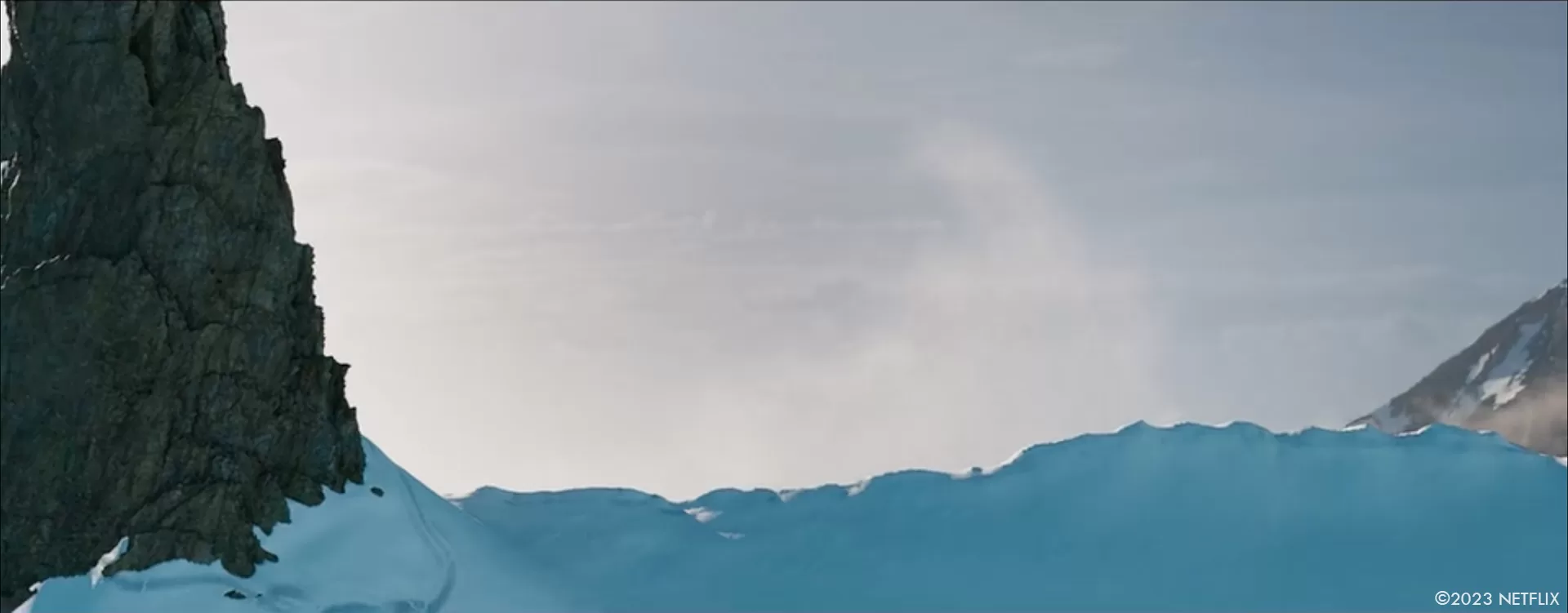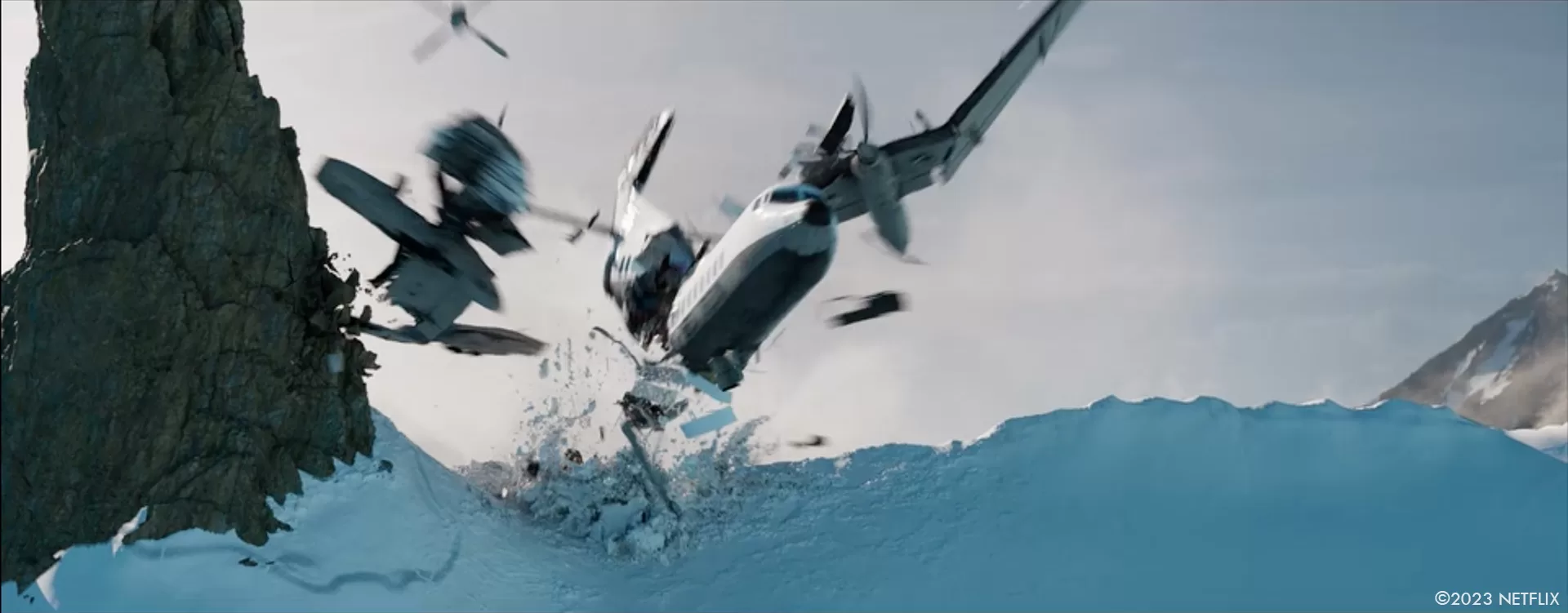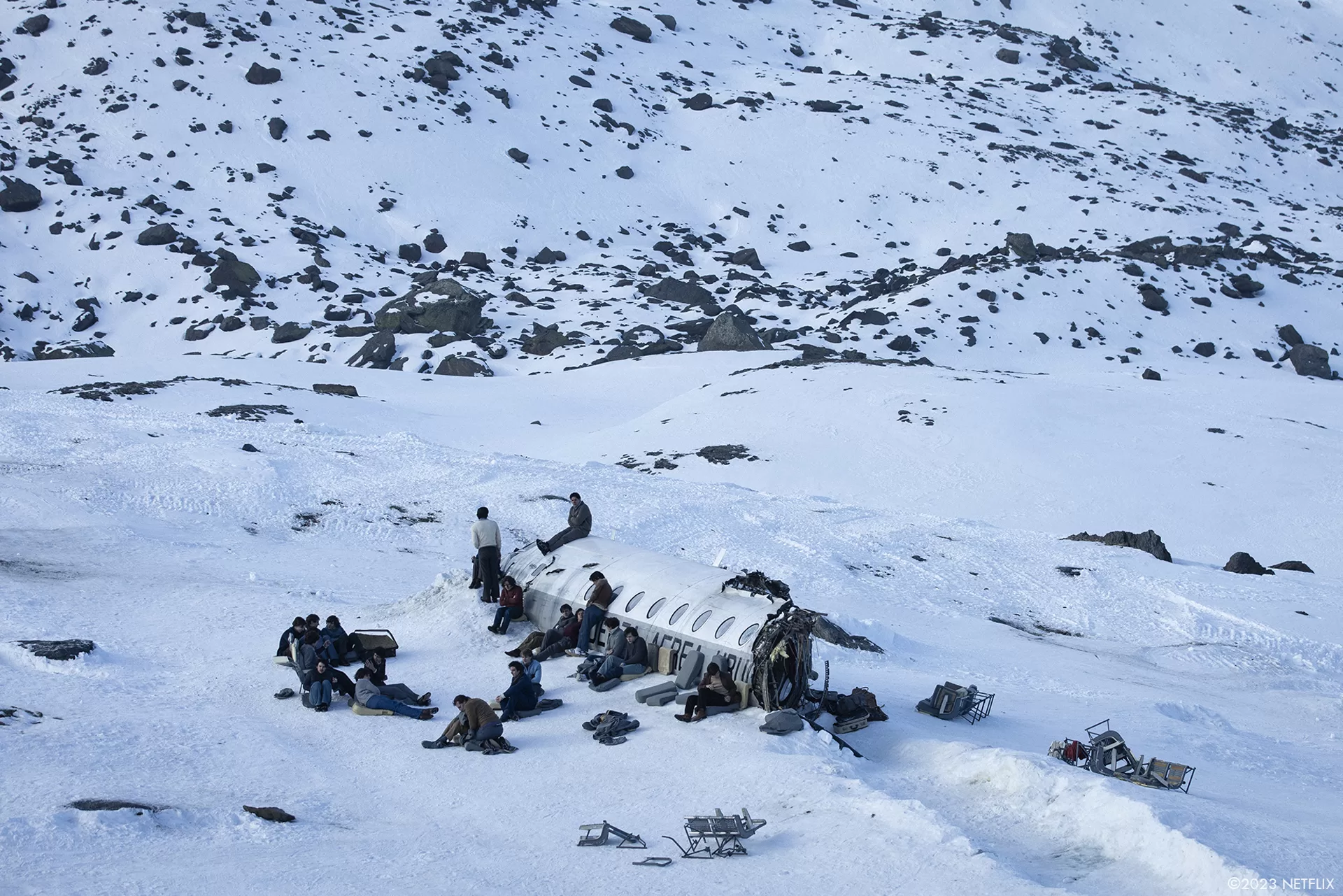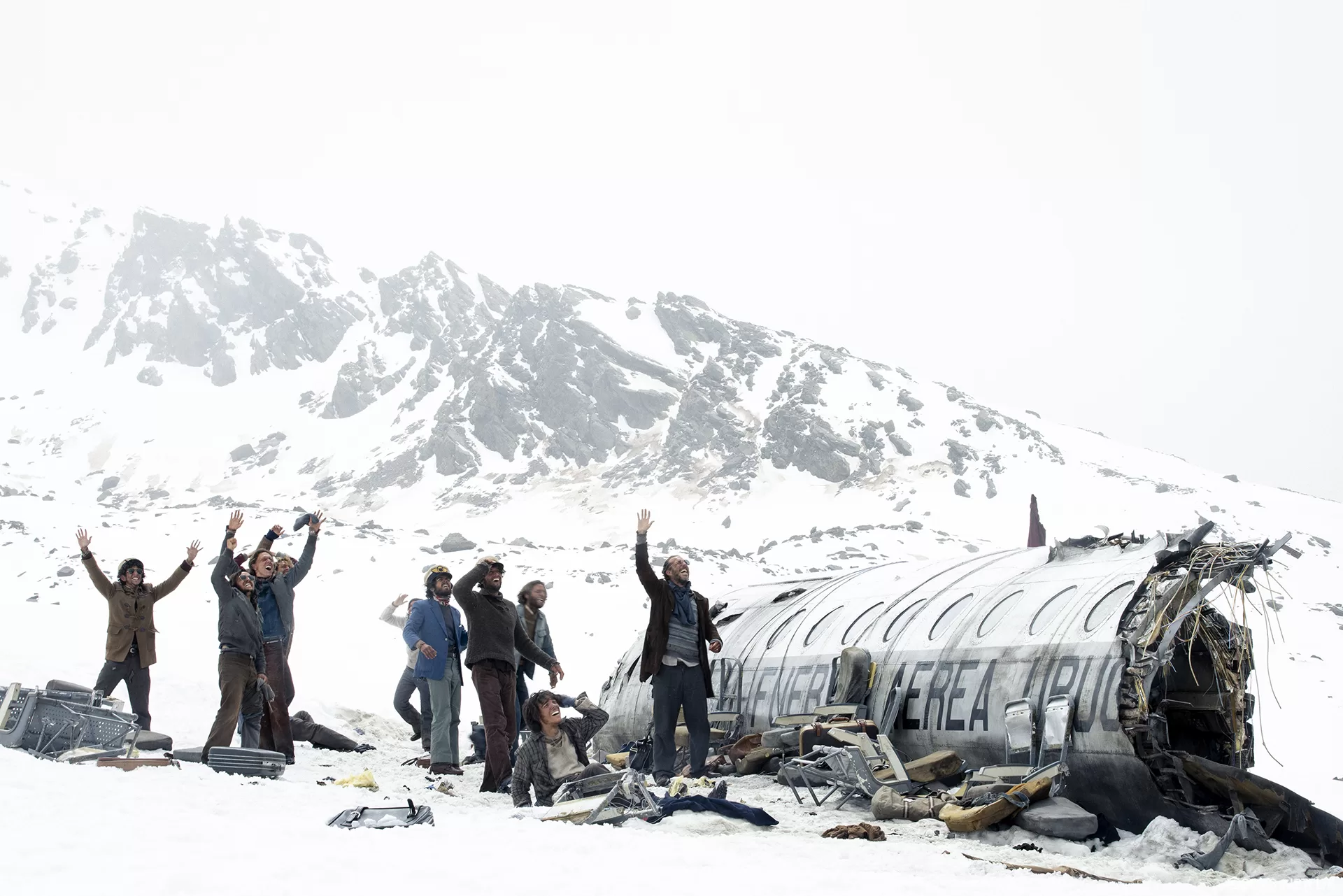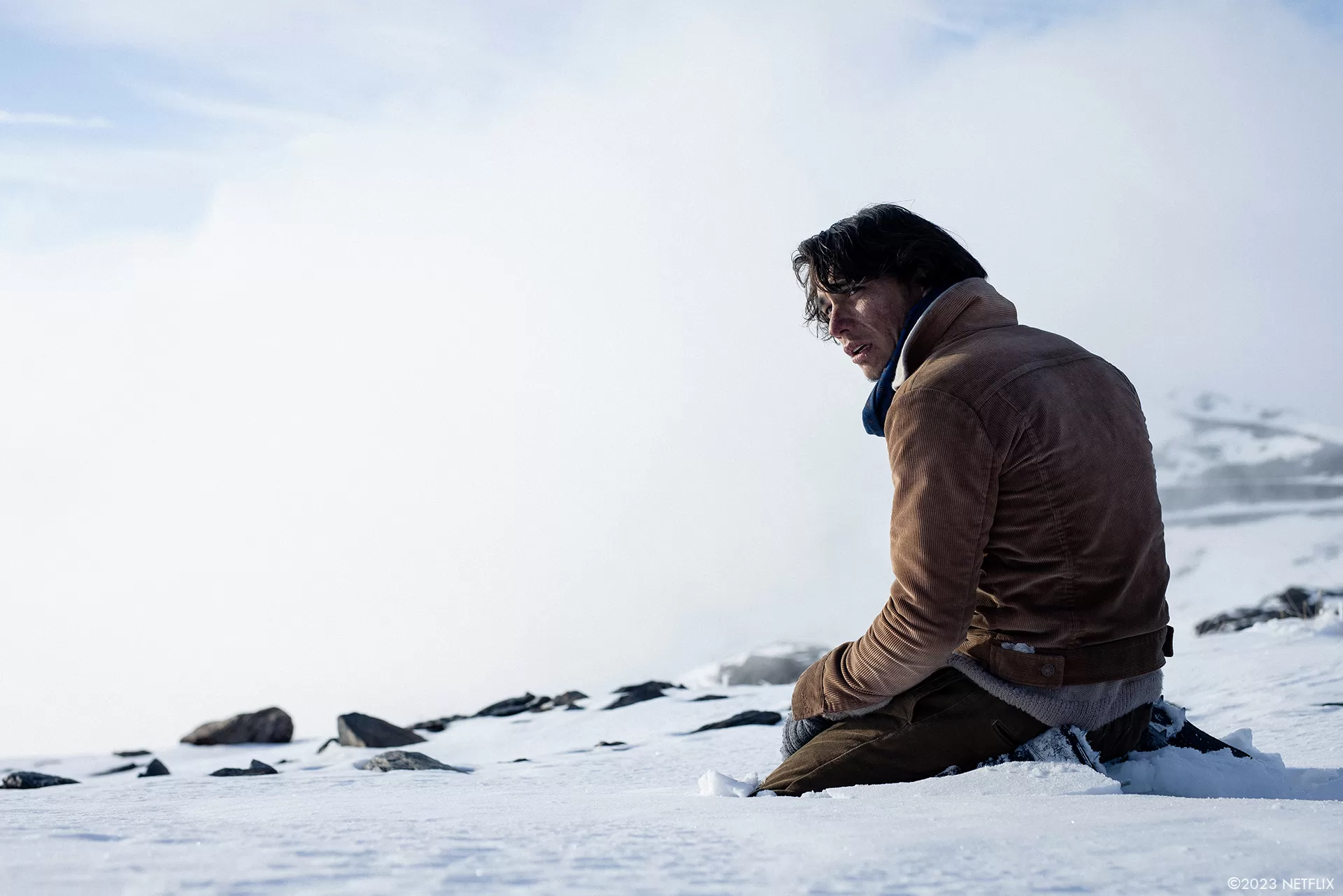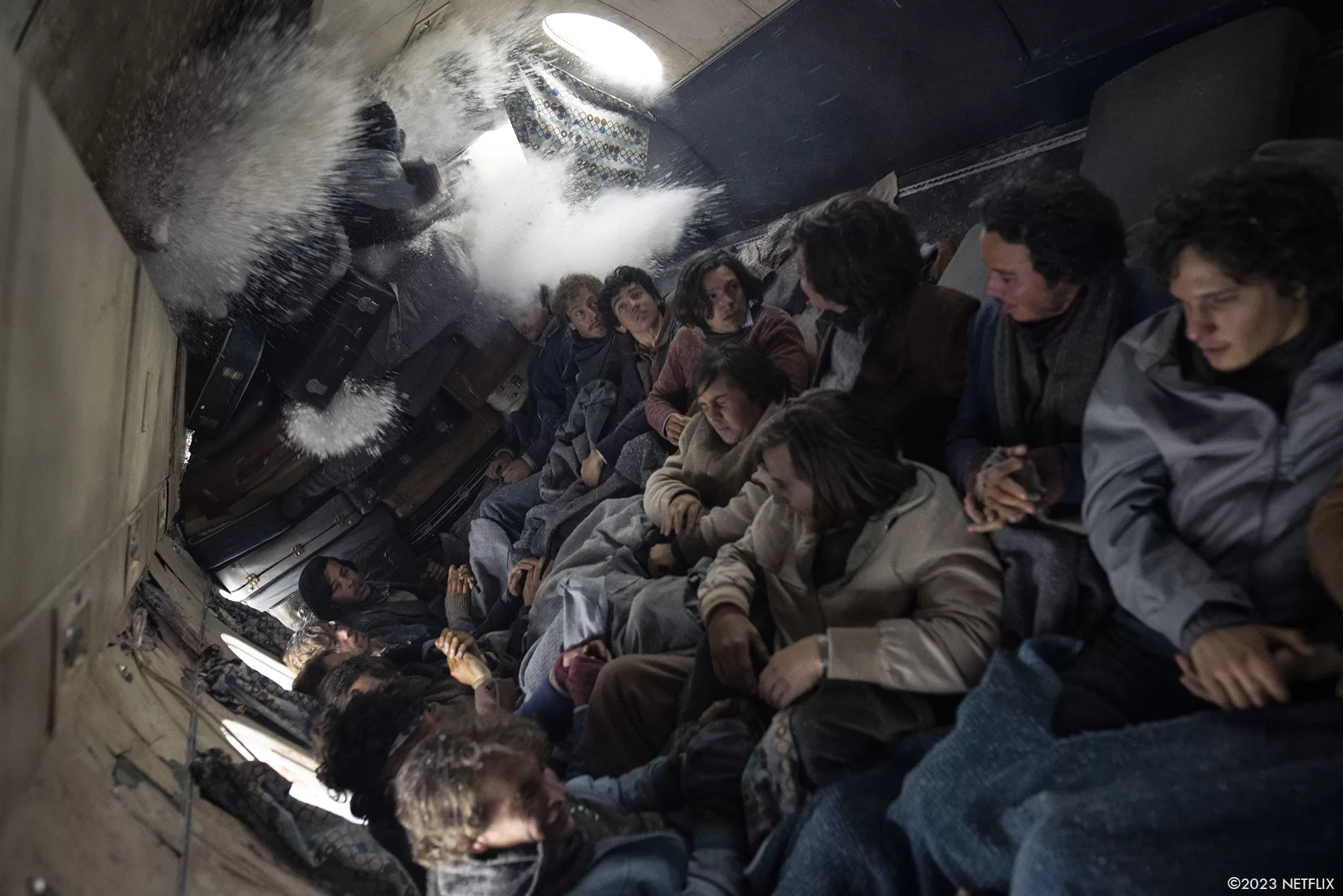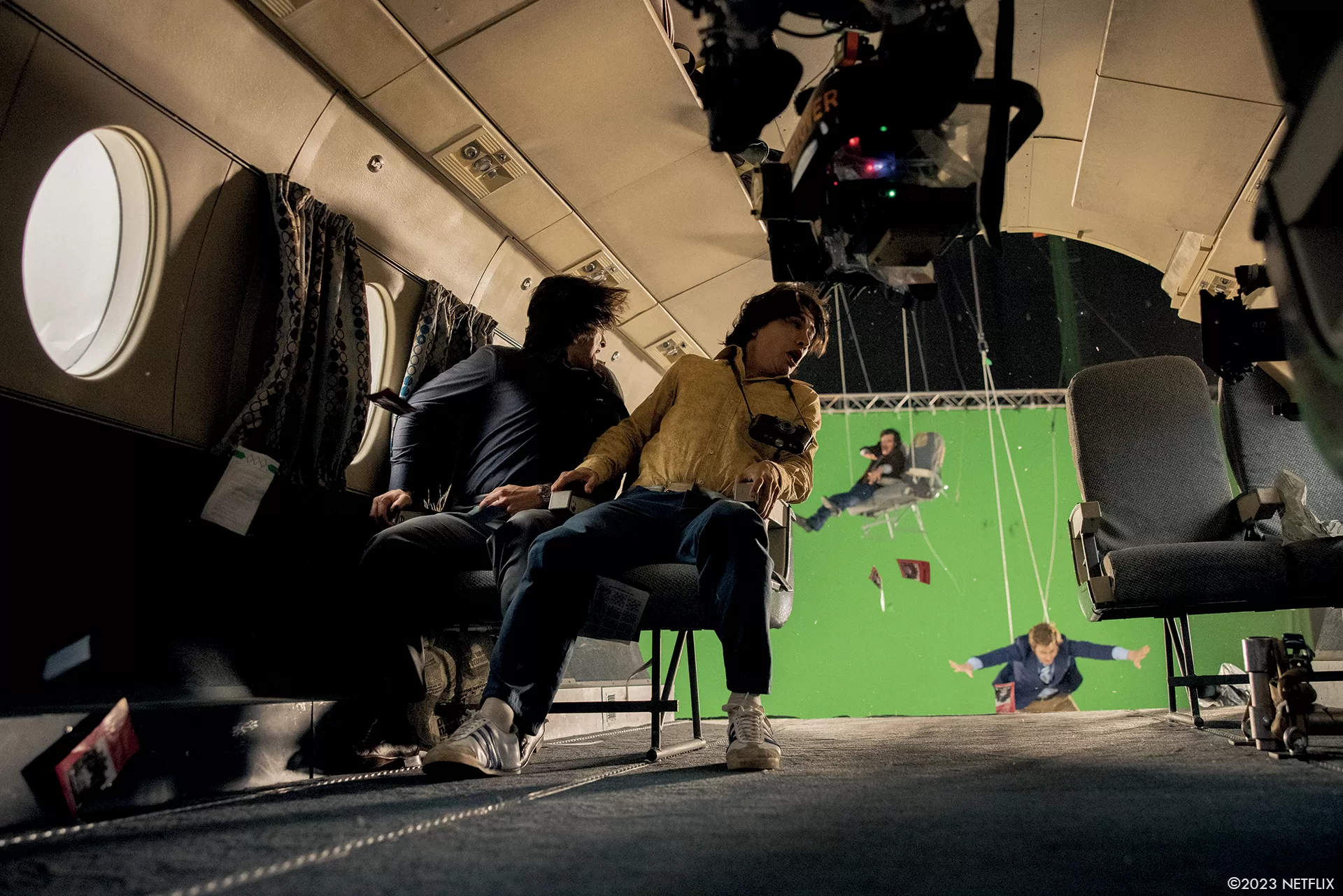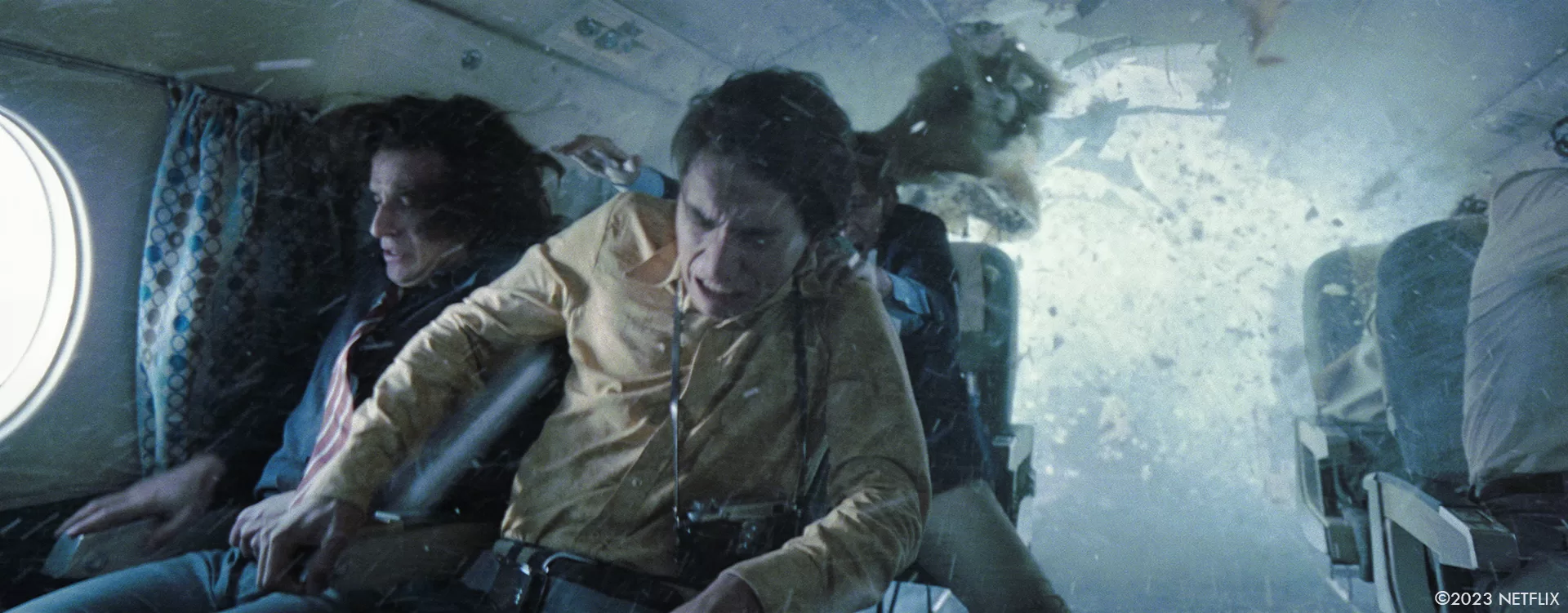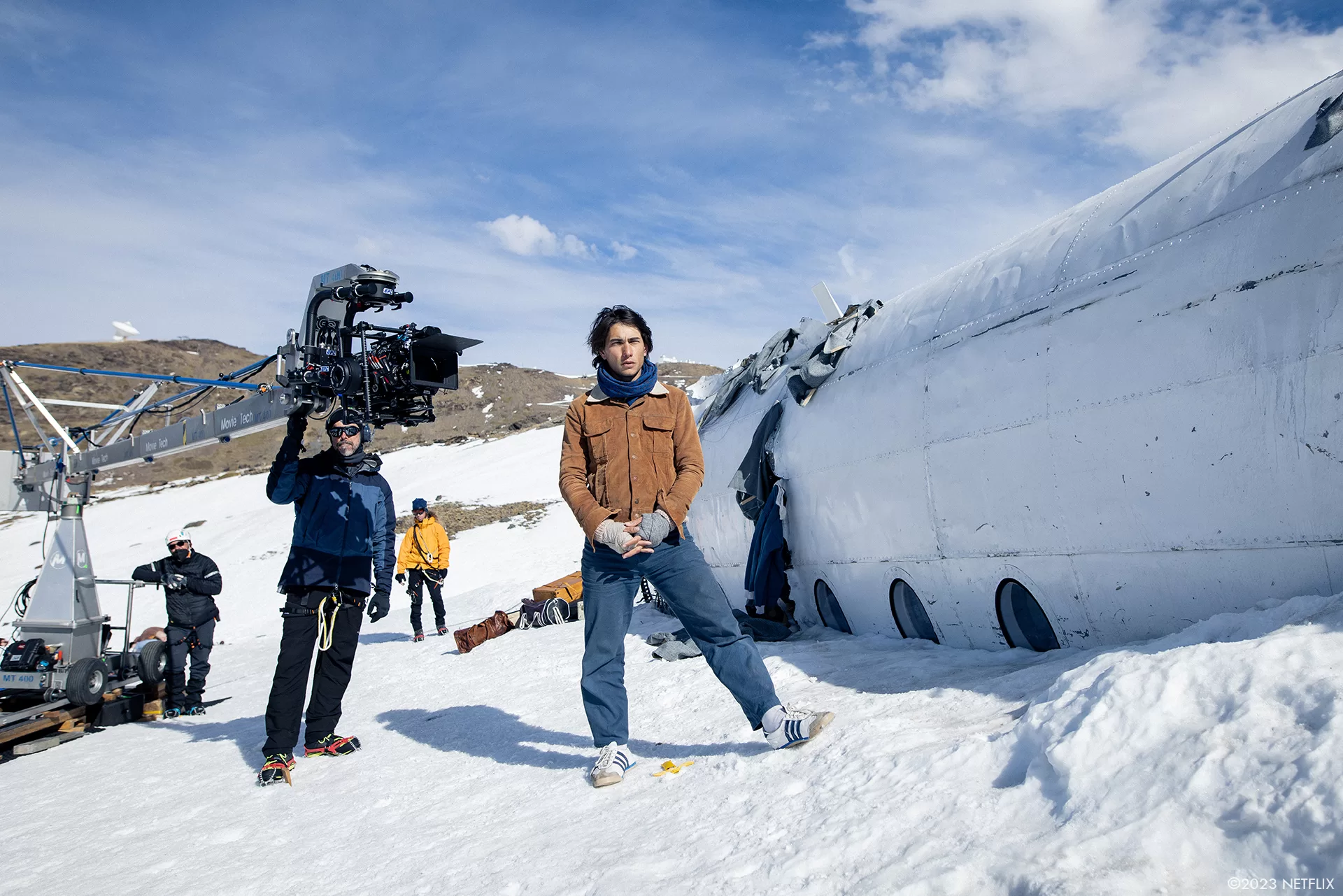Prior to joining Rising Sun Pictures in 2017, Julian Hutchens had worked at a various studios like Framestore. He has worked on a many films, including Edge of Tomorrow, Paddington, Alita: Battle Angel and Elvis.
What is your background?
Like many in the industry, I have a photography, art and design background. Both my parents are artists, my mum’s a jeweller and my dad’s a painter so growing up it was somewhat hard to get away from following creative endeavours. I became fascinated with 3d animation and visual effects after seeing movies like Jurassic Park and episodes of Movie Magic. Inspired by this, in high school I taught myself Softimage3d and made an animated short film in my final year of school followed by a Bachelor of Multimedia Design which gave me a very broad understanding of art & design principles. Following that, I commenced a government funded internship through Film Victoria at a small post house called Complete Post where I worked as a 3d generalist artist on commercials and small-scale films. As it was a small studio we worked on a very broad combination of projects which exposed me to many creative and technical challenges. It was in this role I got to wear many hats and dabble in many facets of post-production. In the peak of the world financial crash I decided to leave that stable job and venture off to London, where I soon after began working at Framestore in London in lighting/lookdev, followed by helping to set up their studio in Montreal several years later. After nearly a decade away from Aussie shores, it was time to return to Australia and Rising Sun Pictures looked like the perfect fit.
How did you and Rising Sun Pictures get involved on this show?
We have a terrific working relationship with VFX producer Kathy Siegel from previous James Mangold collaborations, like Ford Vs Ferrari. This paved the way for another opportunity to work together. I was just finishing up on Elvis when I heard we would be working on the next Indy and I immediately put my hand up to get involved.
What was your feeling to be back in this iconic universe?
Being such a massive fan of the original films, I felt a huge sense of responsibility. I cherish the original films for their sets, lighting, texture and ambience and I knew that our contribution must stand up to that level of detail to enhance the story and extend what could not have been caught in camera on the day. The visual effects had to feel real and support the story. It was a real ‘pinch-yourself’ moment when we all watched the first glimpse of the parade sequence edit as a team. Everyone was so excited to be a part of this journey and the whole team really brought their best!
How was the collaboration with the Director James Mangold and VFX Supervisor Andrew Whitehurst?
Andrew was very much on the same page as the Director throughout the whole post process. He very clearly communicated what the director was looking for in any given shot or sequence. He presented concepts and research all of which was pre-approved by the Director and production designer, so from the get-go the expectation was clear and we were trusted to deliver that vision. We were told that Jim is not going to be concerned or dwell on minute details and expectations, but rather the over all picture and mood. Our additions had to feel real and tangible. A major part of visual effects is really understanding what the director wants for the story and making sure we are all aligned with that vision, working with Andrew was a pleasure and it was clear from the first call we were all well aligned.
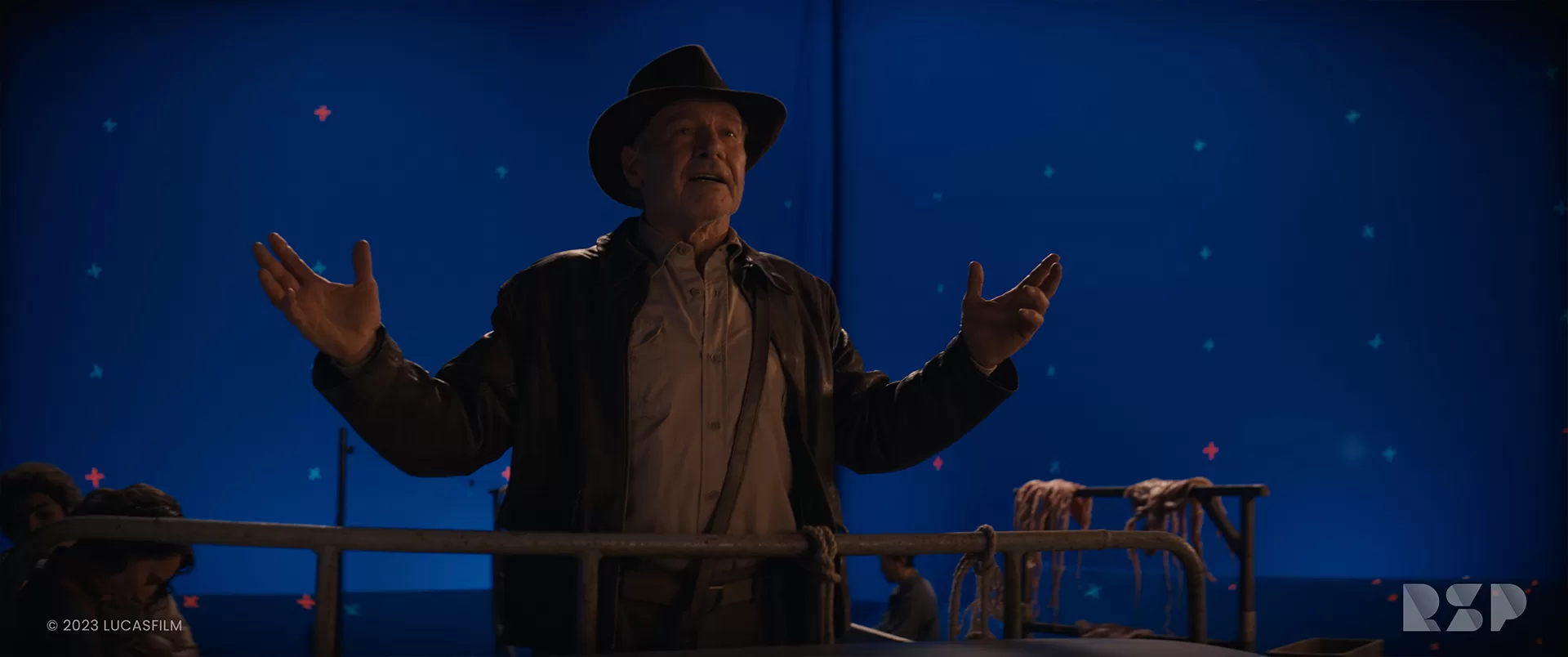
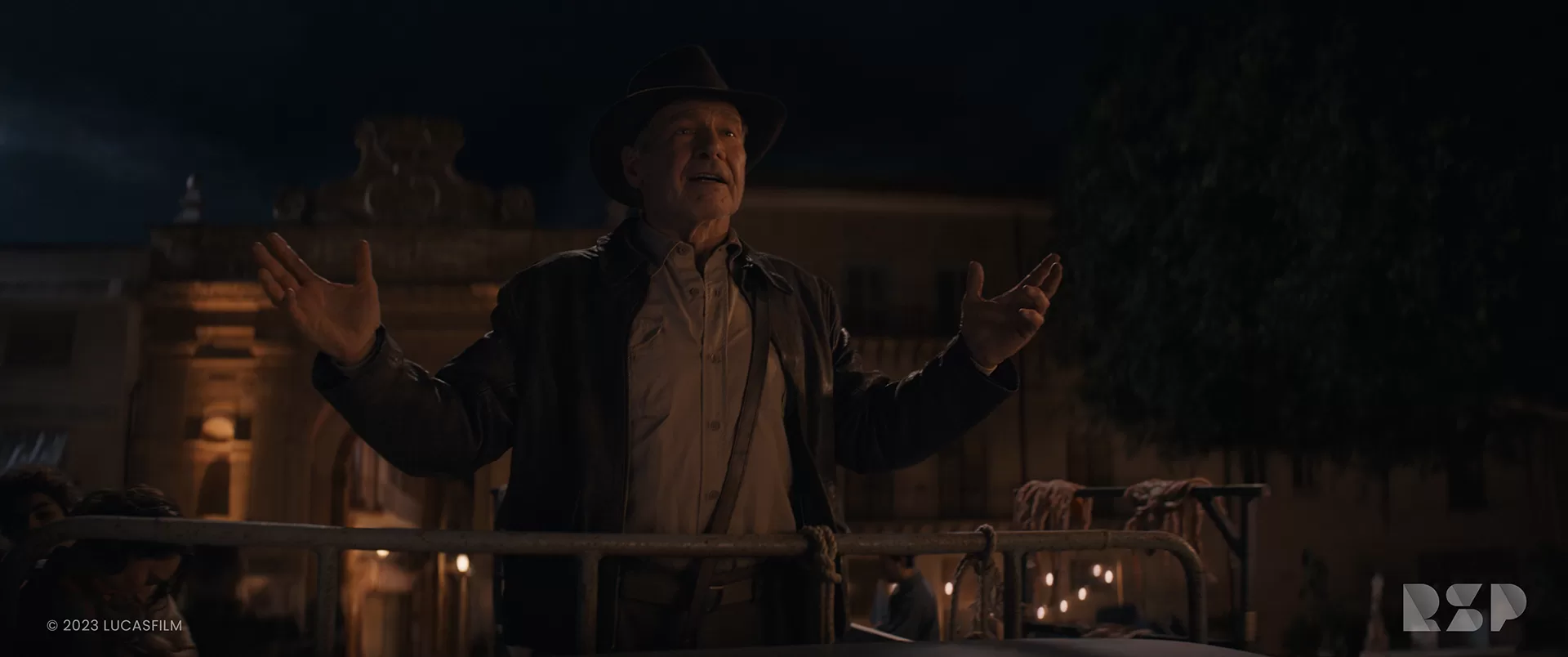
What was their approach about the visual effects?
Everything had to feel like you could reach out and touch it, as though it could have been caught in camera, rich with detail and have a purpose in every shot. Our work needed to sit into the visual language of the film and co-exist in support of the story without anyone really noticing it was there. Indiana Jones is all about history, the locations within the film are all real places albeit in the past, we wanted to ensure each location had a sense of authenticity complete with imperfections.
How did you organize the work with your VFX Producer?
With any complex VFX challenge the first step is to really understand what the Director wants for the story and how will the addition of VFX enhance that vision. It all begins with planning. Breaking down the big challenges into smaller achievable goals. We started with interpreting the client led concepts into our own paint-over concepts using key angles of the plate photography. From these Director approved concepts we broke down our prop/dressing and FX needs, Hero model requirements vs procedural construction aims. By breaking down the work into those categories we were able to focus detail and attention where it was most appreciated and required for the story.
What are the sequences made by Rising Sun Pictures?
RSP had an extensive contribution, we were the second largest contributor of VFX and the majority of our work was within the second act of the film, from the moment Indy wakes up in his apartment in New York to his departure from Idlewild airport. We worked on extending his neighbourhood in the lower East Side, the Hunter College rooftop chase, Kidnap journey, escape through the streets, Moon landing ticker tape parade, Subway chase, various NY night locations and Departing from the Pan AM terminal. Not to mention the closing shot of the film with the camera rising from the street to Indy’s balcony, along with collaborating on an iconic map journey and supporting shots during his capture and journey toward the past.
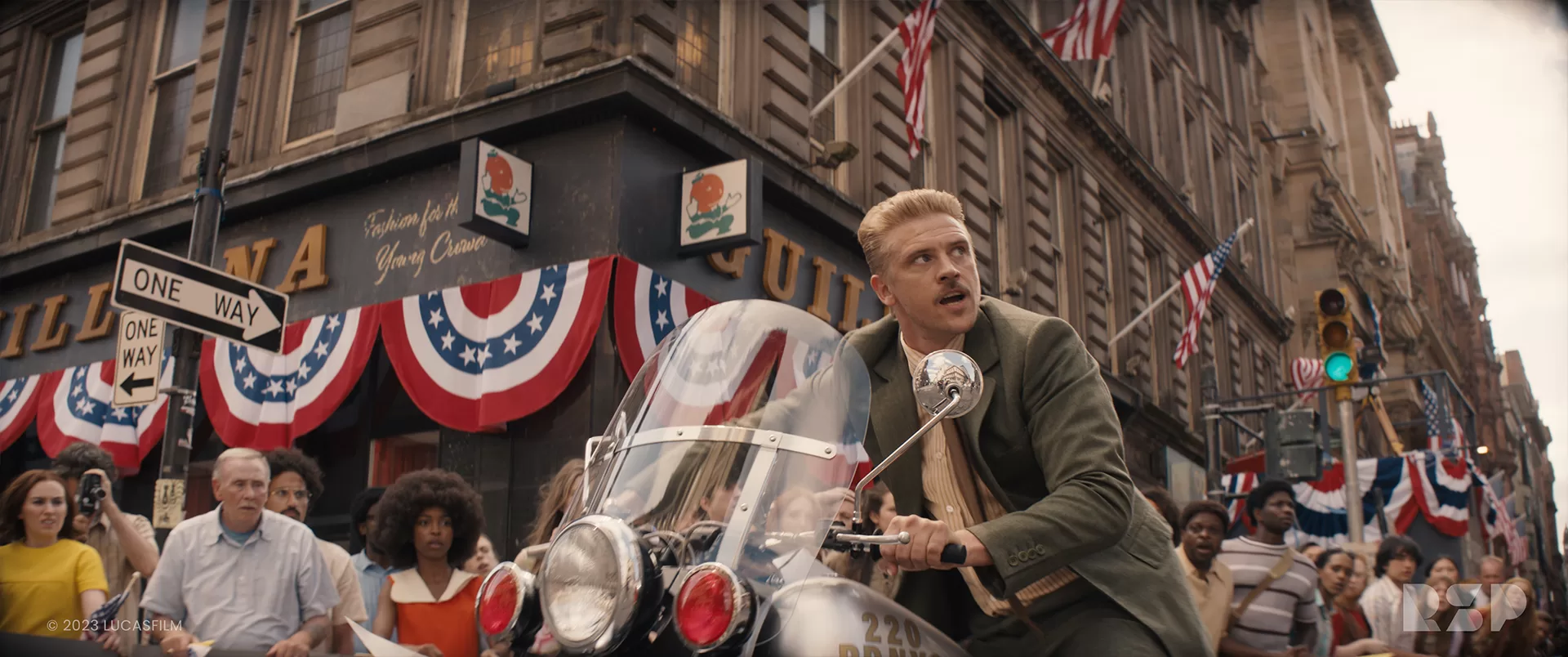
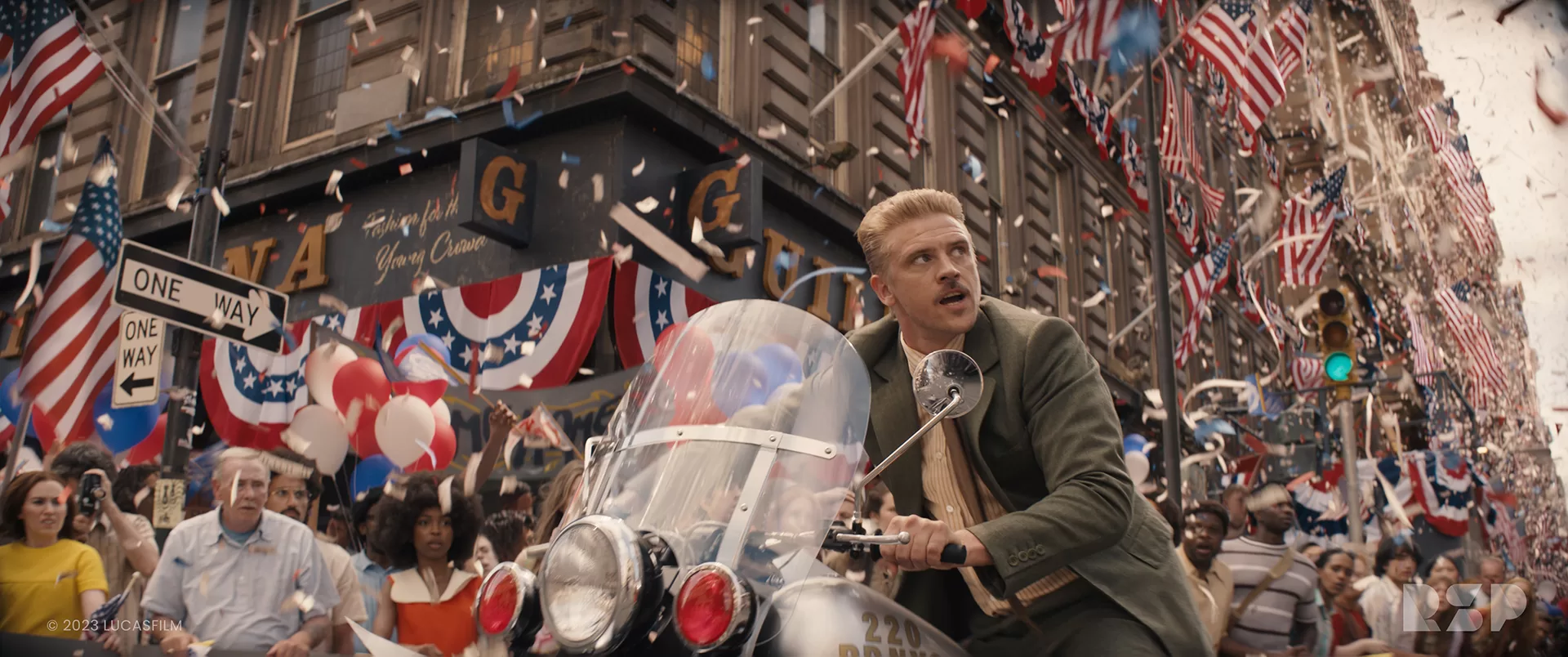
Can you elaborates about the design and creation of the New York environment for the ticker tape parade?
We were presented with extremely rich, detailed concepts which encapsulated the gritty mood of New York the Dir and Production designer were aiming for. Various key scenes were depicted in this study and accompanied by historical referecne photography and archival footage. This collection provided a strong foundation for our concept team to re-interpret these palettes/textures/structures into our own paintover concepts based on key frames from the initial turnovers to help form a blueprint for the look of late sixties New York. The Parade chase was filmed in Glasgow and therefore already had several blocks worth of buildings in camera, we had to be careful when designing our top ups to remain cognisent of the structure below and its style whilst also designing additional floors that caried the New York flavour. This required a lot of hero modelling and strategic decisions on where to cut from the plate. Fortunately we had a highly detailed lidar which covered several blocks, with this we were able to accurately lineup our digital extension to continue from logical join points like architraves and other horizontal building features. Beyond the hero modelled topups the rest of New York was based on a proxy Manhattan we had built from geo survey data. This proxy was trimmed to keep building heights to 1969 levels and provided the base for our procedural modelling features to be sculpted and instanced to add scale and detail.
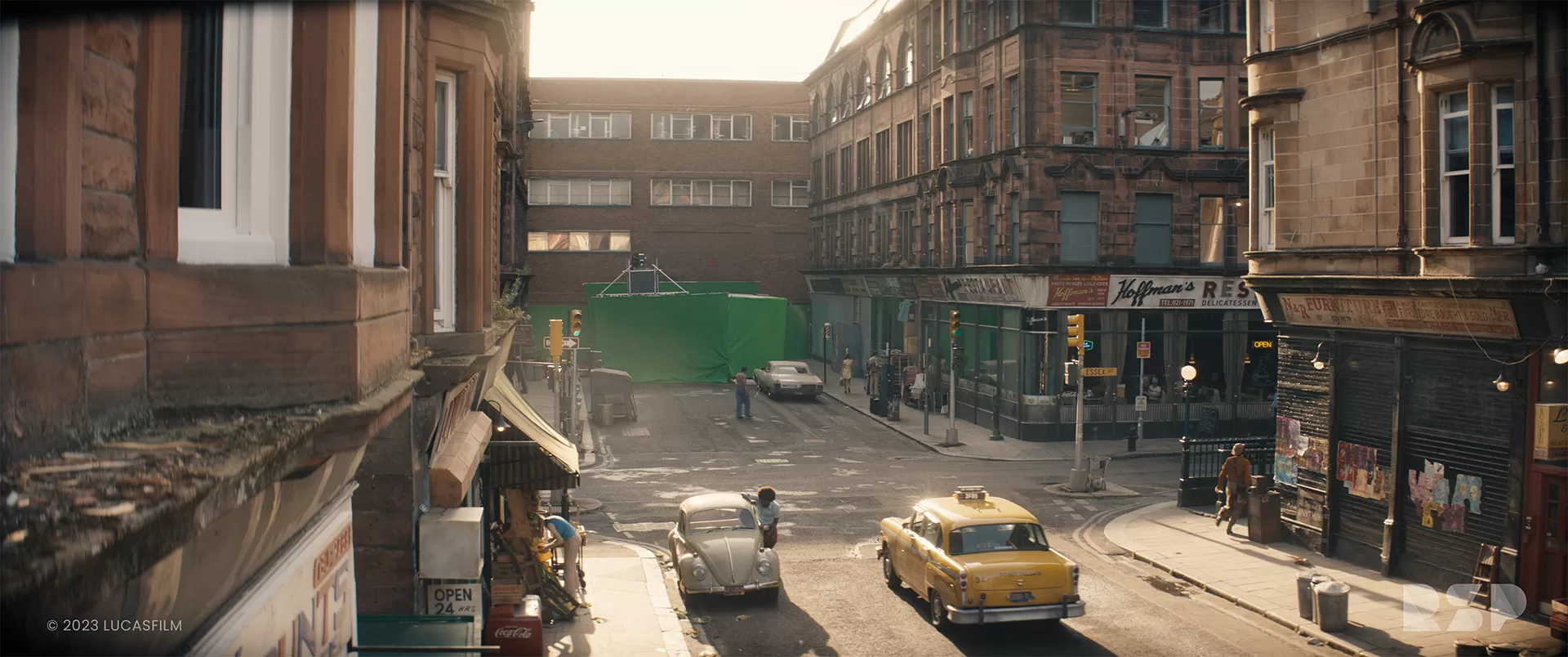
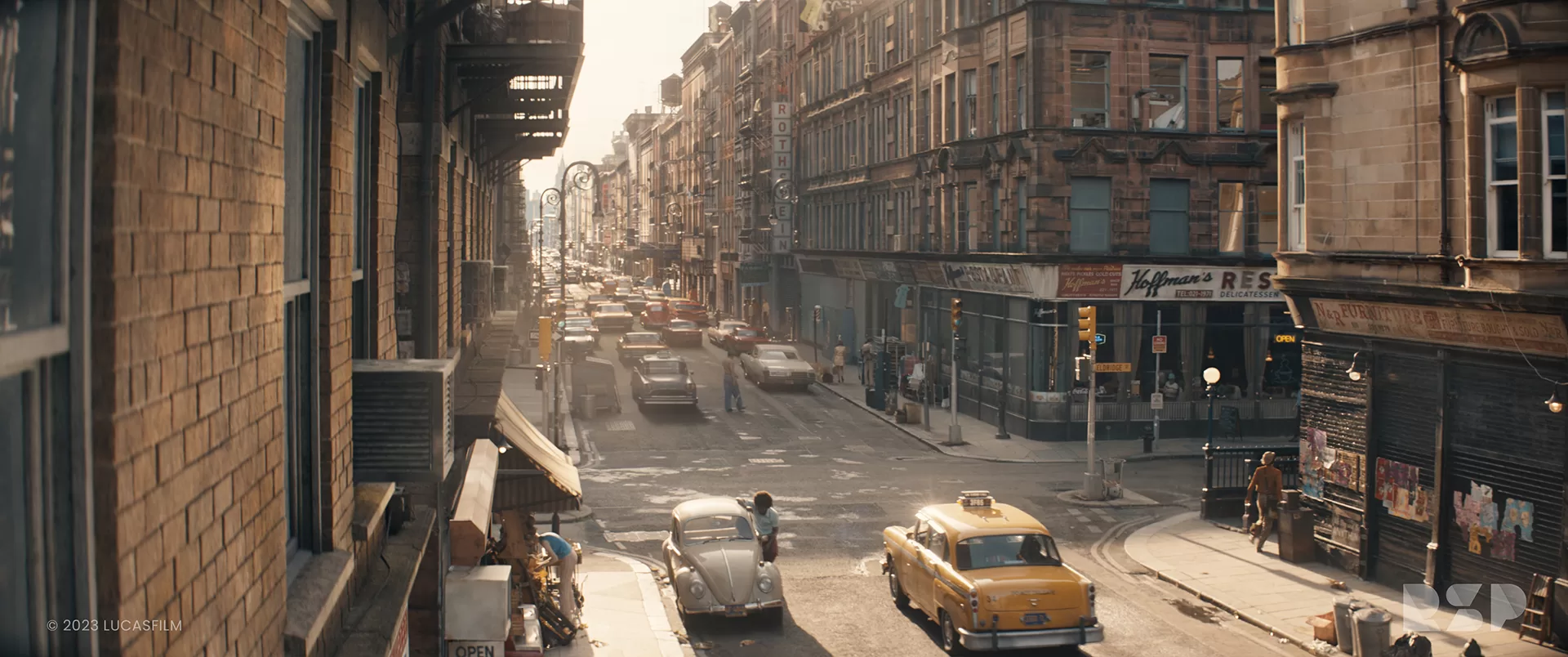
Where was filmed this sequence and the size of the real sets?
The ticker tape parade sequence was shot in Glasgow across several city blocks. The key to transforming Glasgow into New York was to really embrace what was in the plate photography however minimal. We knew we wanted to keep at least the bottom story of every building, complete with its set dressing and adornments to ensure our extension was grounded and based on something tactile. Pushing us to live up to that level of detail and imperfection in our extended world. Once we had believable top-ups extending out of frame to New York heights the remaining street extension was approached in a more procedural way. By blocking out buildings based on existing NY survey data and making sure we kept the heights period accurate prior to adding the additional architectural adornments and details via procedural means. We wanted to make sure each shot said ‘New York’, from iconic yellow traffic lights hanging out over the street to roof-top water towers.
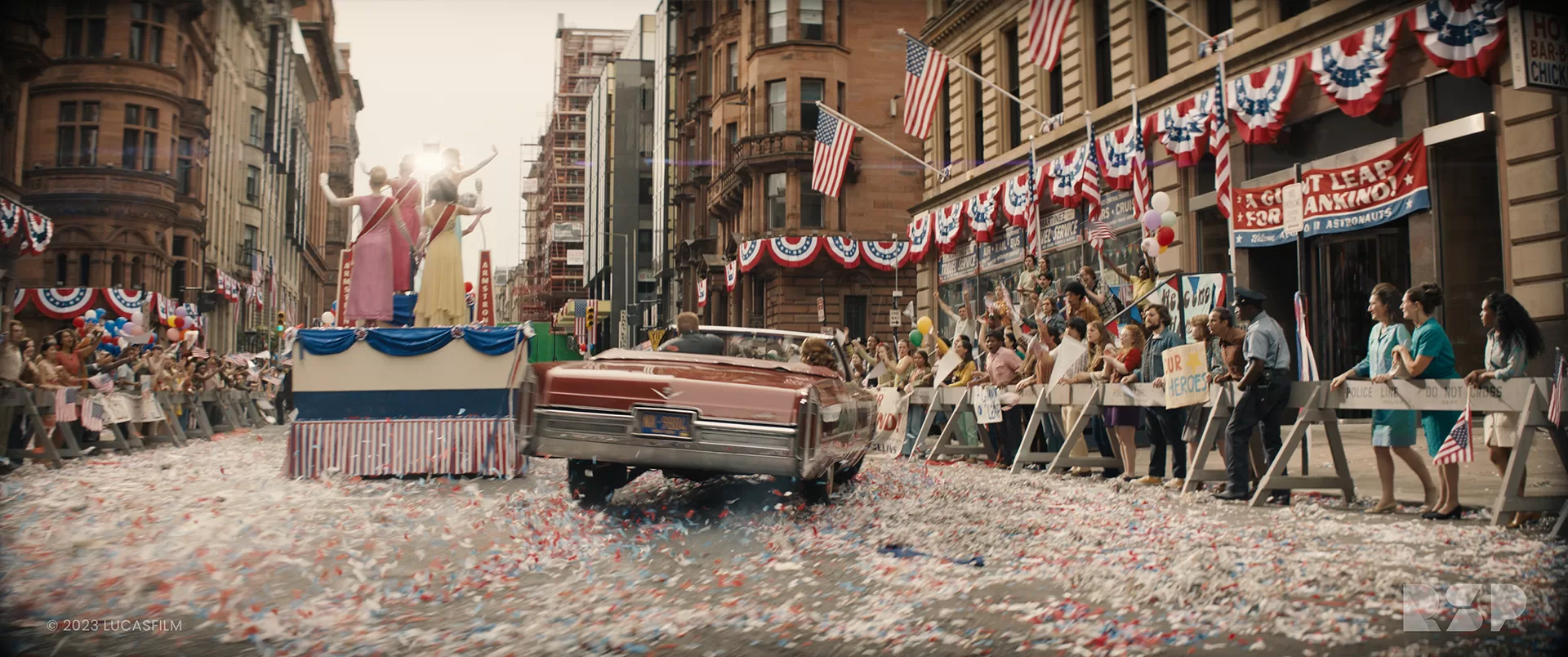
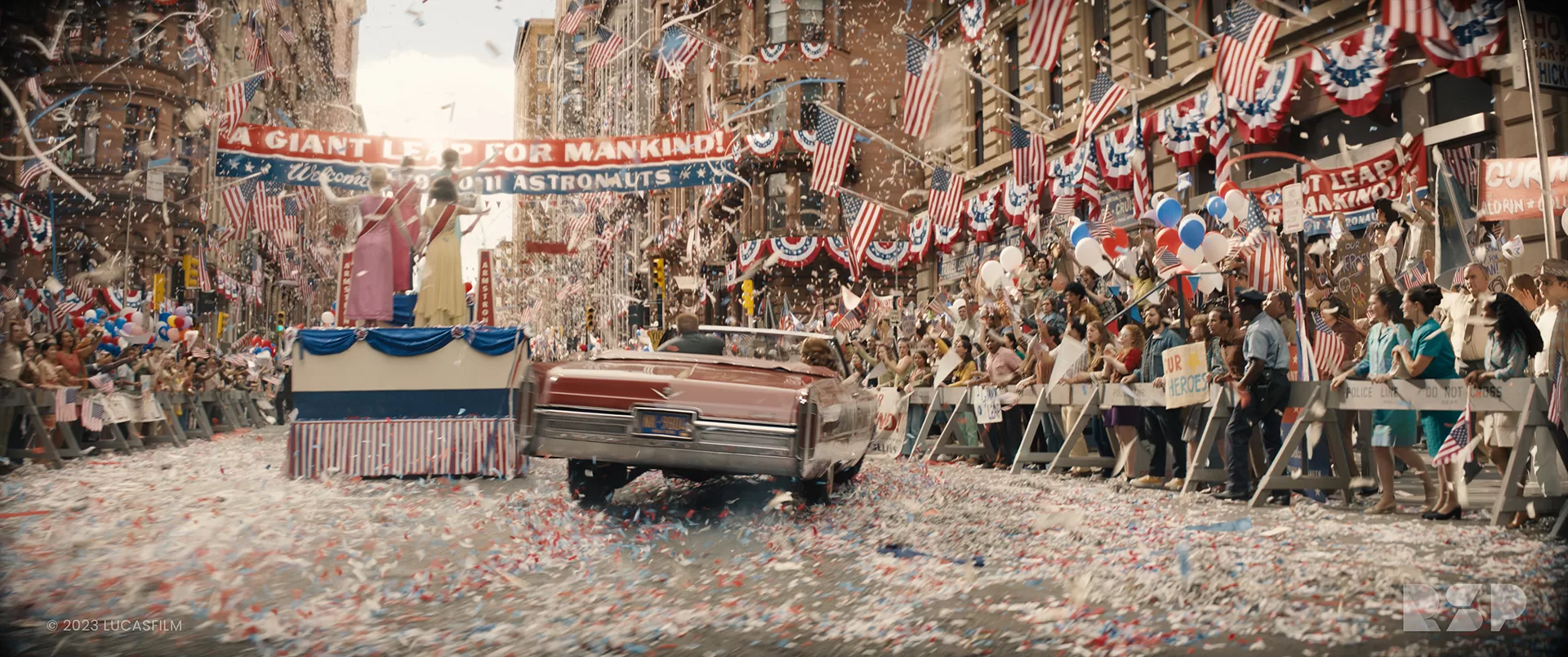
What kind of references and influences did you received for the New York environment?
We received wonderful concepts and period reference photography prior to our shot turnover from production as well as an extensive New York photo shoot of current day buildings and streets. The concepts really established the mood and energy for most of our key sequences including the moon landing parade. The mood, texture and detail with in those frames really set a benchmark for how dirty and rich the visual palette was going to be. From there we amassed a huge library of vintage photography, postcards and aerial images to help inform the look and feel of each environment. We wanted to continually ask ourselves based on this reference material what details we could add to help enrich the extensions from the plate photography. We didn’t want there to be any sterile straight lines, perfect edges or clean surfaces; it all had to feel real and imperfect to be believable. We knew the Director and Production designer were both New Yorkers, so the bar had to be set high.
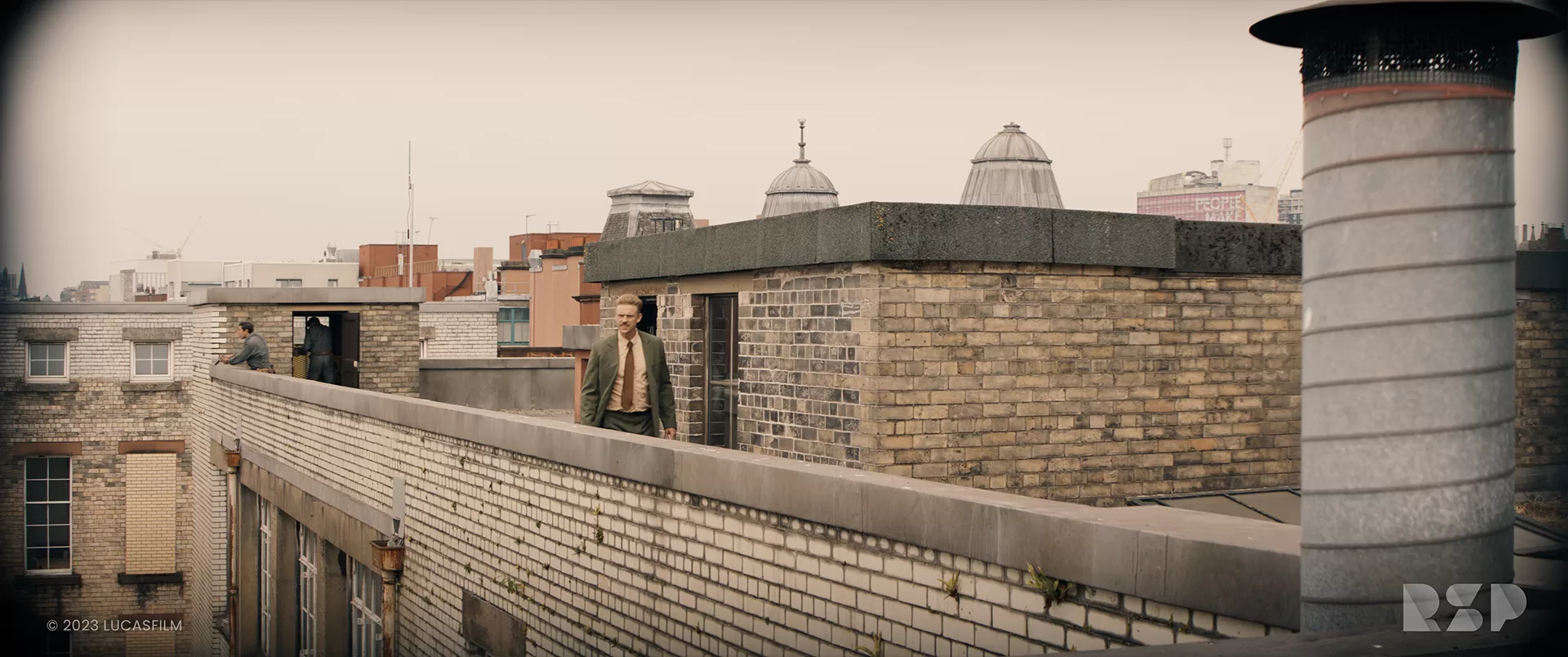
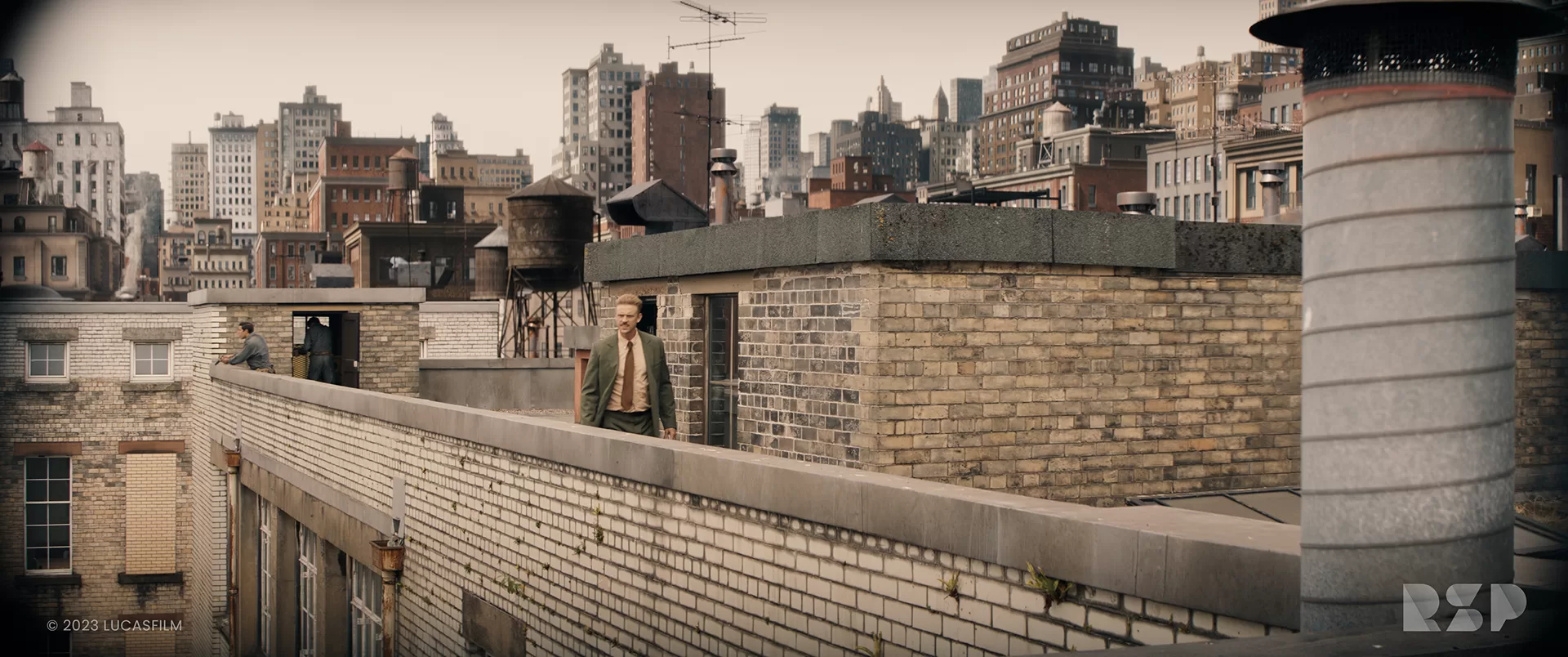
How did you populate the streets?
The streets were populated with a vast library of purpose built 3d assets based on the cars, crowd extras, props and adornments used on set, along with additional buildings and their rooftop dressing. We used a combination of hand placing street level props, like parked cars, telephone boxes, traffic lights and trash cans along with procedural dressing on our buildings, like air-conditioning units and rooftop greebles. We matched the location of parade stands, crowd barriers and live action crowd per shot so that we could dress in a digital crowd to fill in the gaps, complete with banners, flags, balloons and children on shoulders.
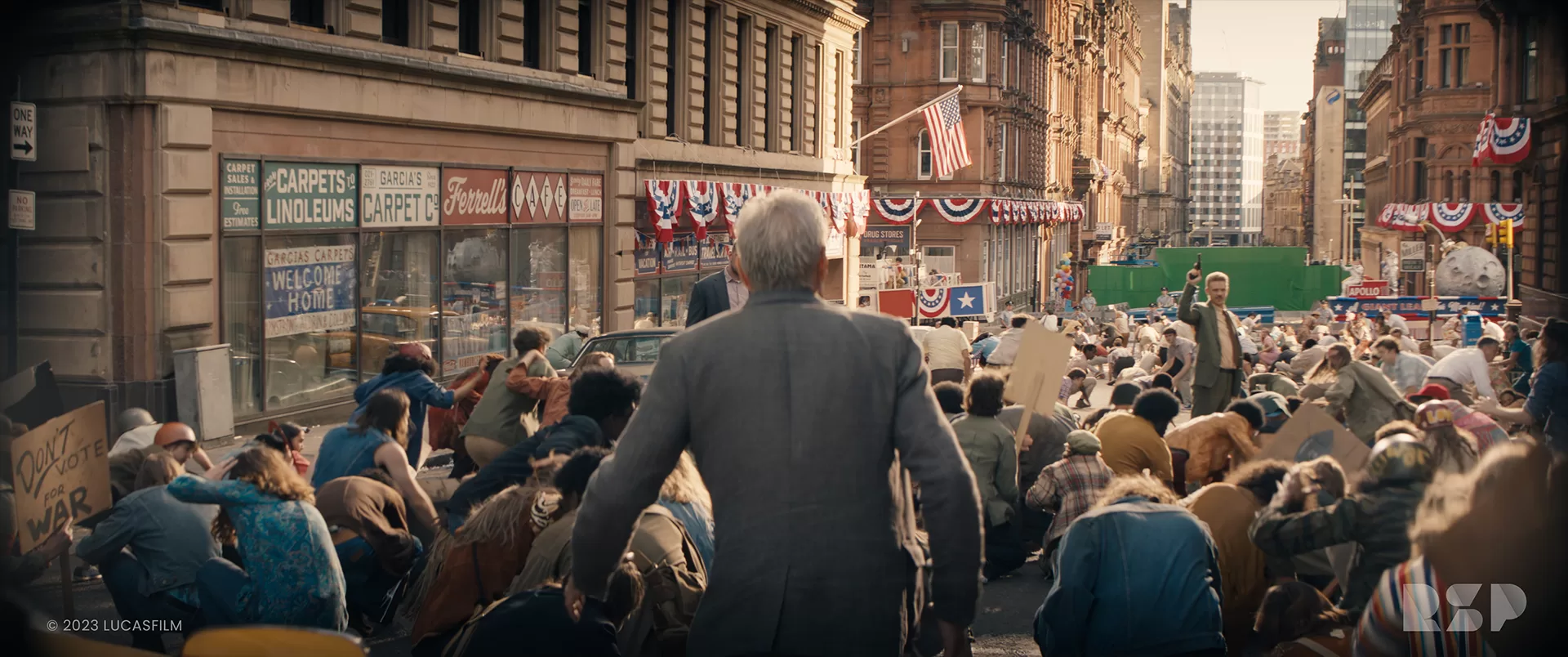
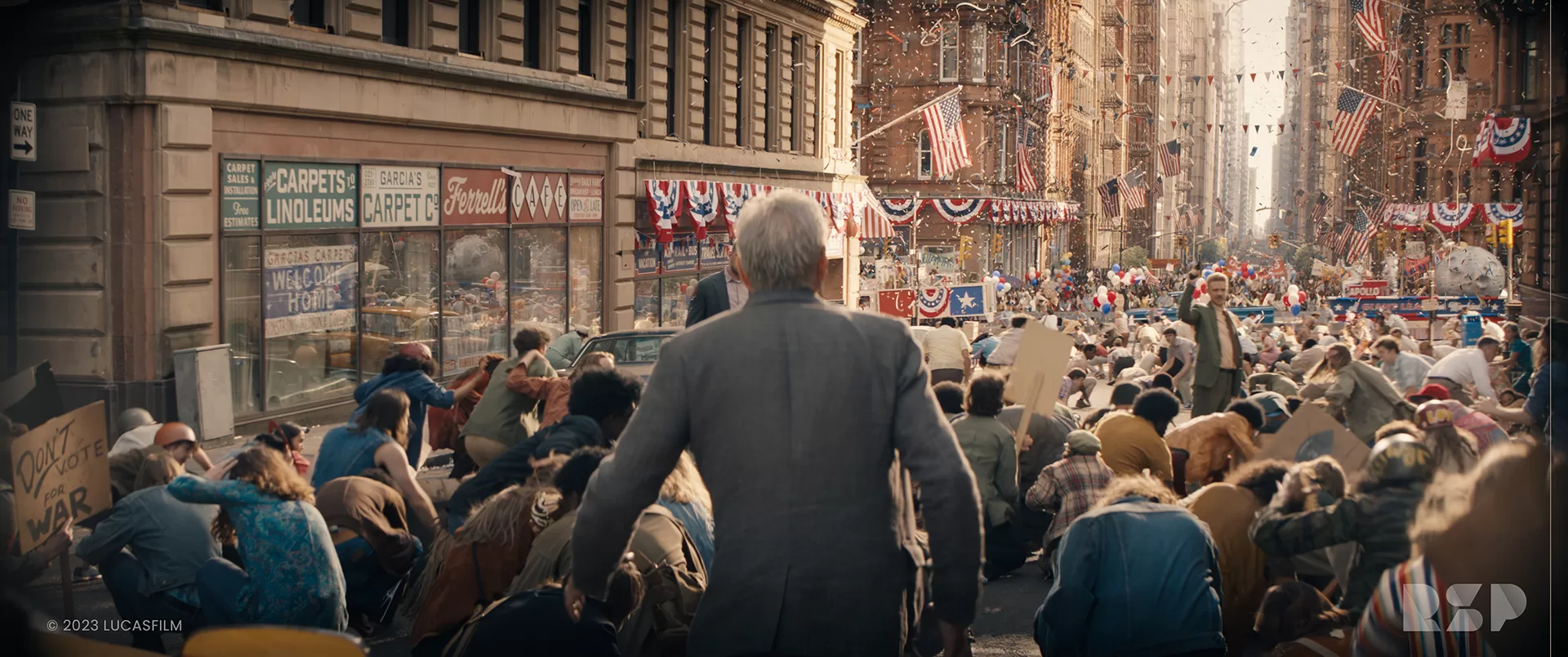
How did you create the various digital doubles and the CG horse?
All our crowd agents were built from the enormous library of extras which were captured on set. We procedurally extracted the vector displacement map detail with accompanying coloured textures and applied that to a number of varied low poly ‘body socks’ to ensure detail was only engaged when required at render time and based on the needs of the Camera Angle. For the crowd performance we conducted several motion capture shoots to make sure we had a diverse library of actions and behaviours to help bring the parade to life. There was cheering, ribbon throwing, holding balloons, banners and waving flags to name a few of the nearly 100 unique actions.
Our Horse asset was based on reference supplied by production. All wide shots of the horse where captured in camera, we decided on a CG build to replace the on-set buck used in the mid to closeups, which came with a number of complex challenges. The run cycle had to feel natural whilst the head movements also had to carefully cover the onset buck to avoid additional complex paint when overlapping hero talent. We brought life to the horse by adding subtle blinks, twitches and flowing hair; details that were missing in the plate. By using a digital replacement, we were also able to control the lighting to better integrate the horse in its surroundings, in particular within the subway tunnel.
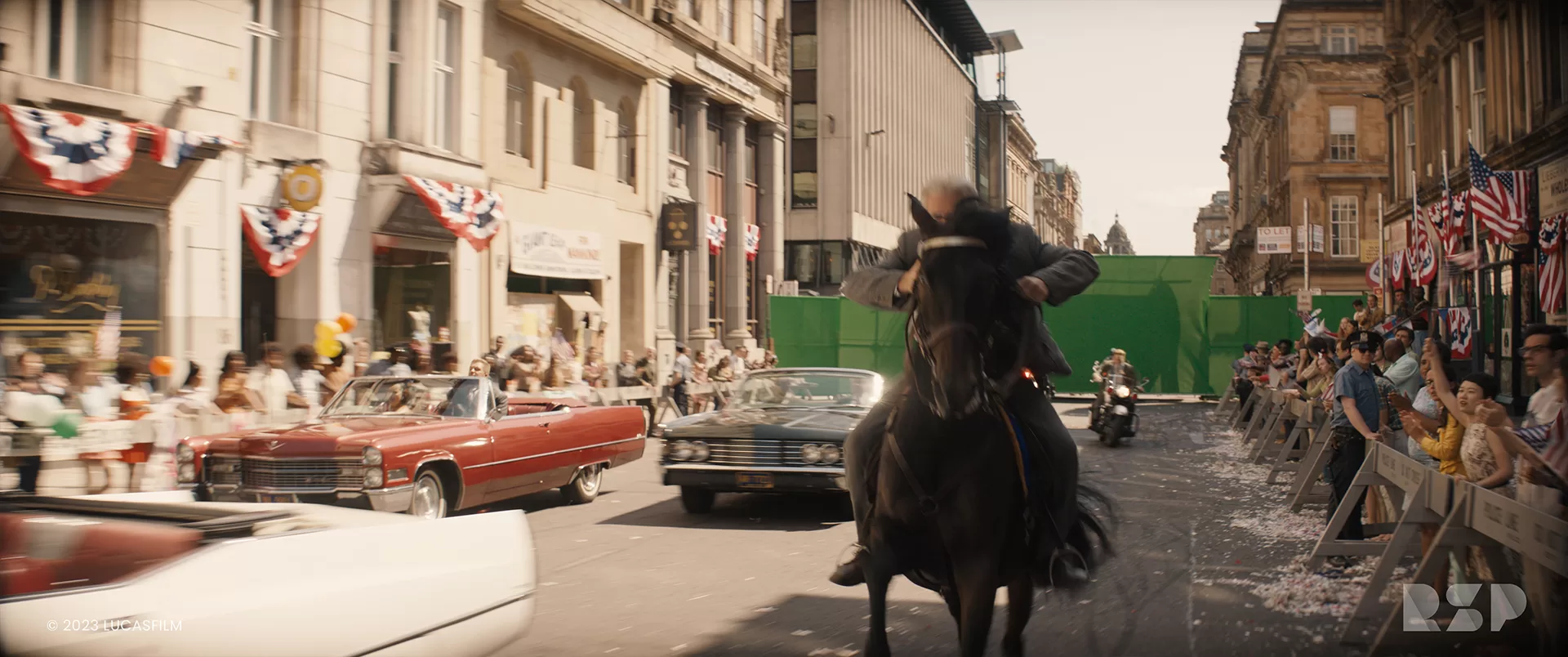
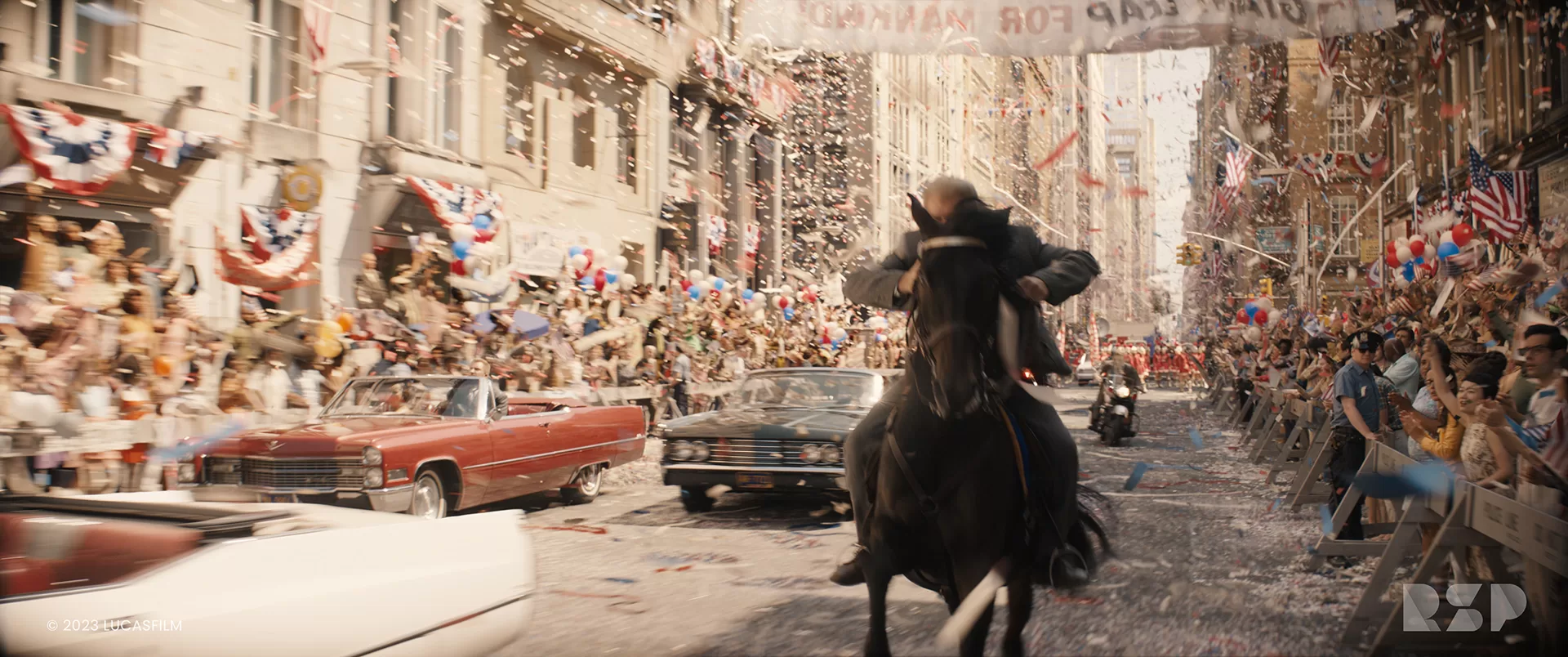
Did you use procedural tools for the parade sequence?
Due to the enormous visual complexity required for the parade sequence many procedural techniques were adopted. Whilst the top ups from the main principal photography where handled with hero modeling and careful asset detailing, The buildings extending beyond that region were procedurally generated from a proxy manhattan silhouette. Architectural details, trims and window frames were all procedurally dressed on the initial proxy footprint for each building based on period reference. The materials were varied via a library of bricks, concretes and renders to achieve maximun visual complexity and variation. We made sure wider based buildings were brick whilst taller narrow ones were a combination of steel and concrete construction. We added blinds, interiors and lights using a window box shader to ensure small frequency details where always present to add a sense of scale to the enormous structures.
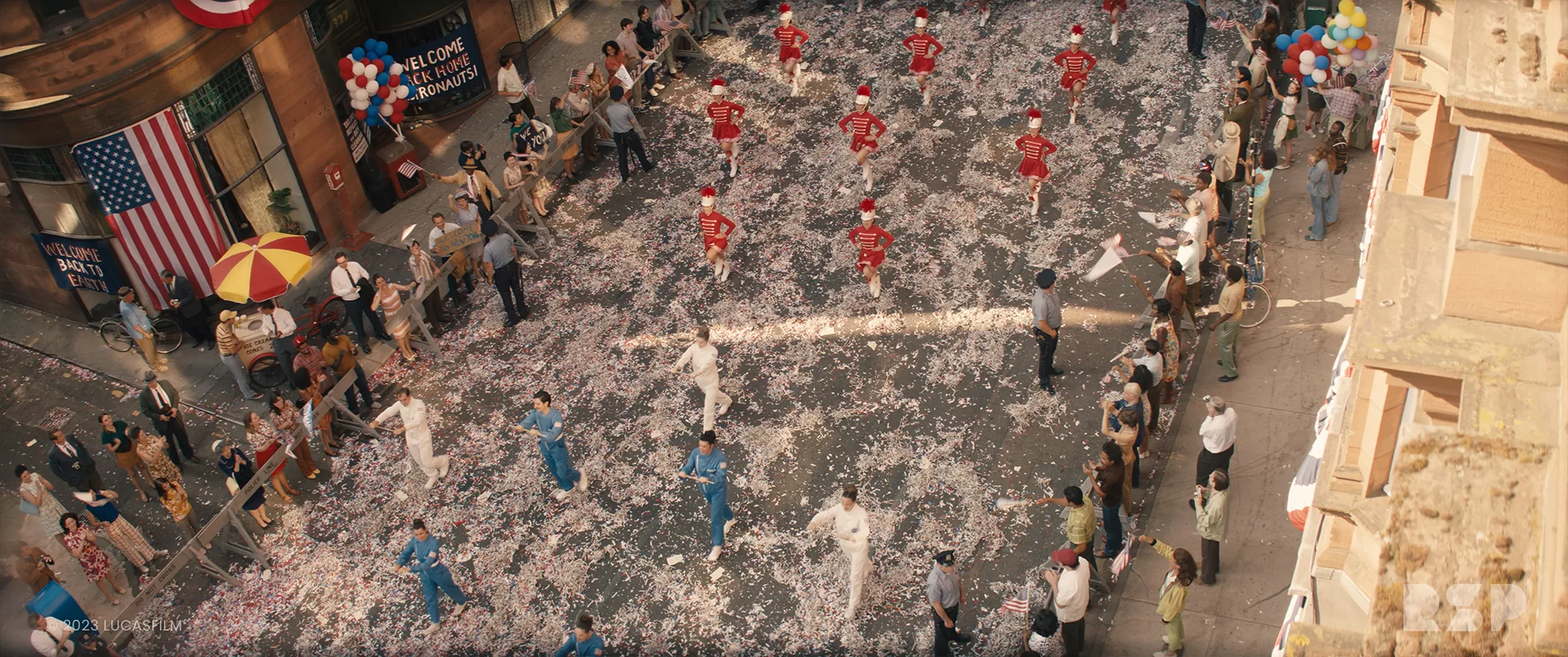
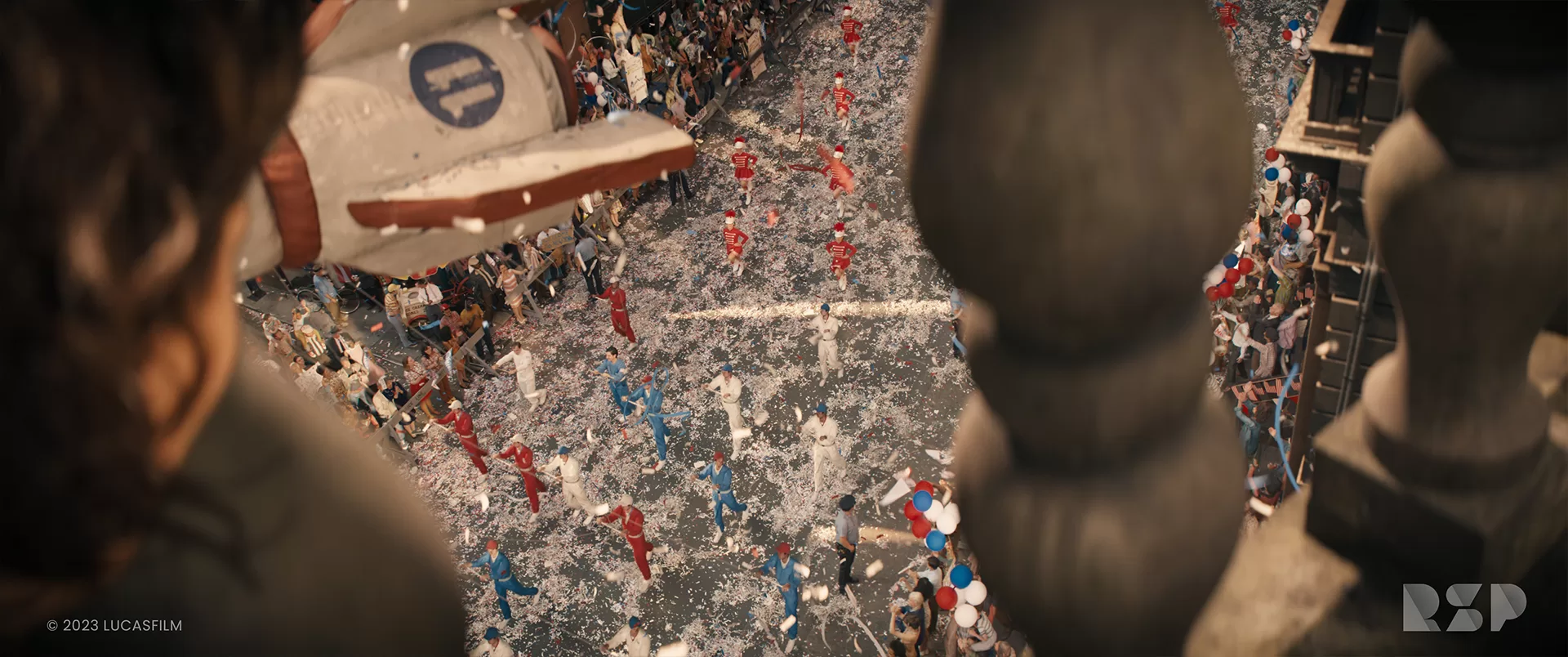
How did you manage the lighting challenges?
The two main lighting challenges on the parade sequence were integration with the plate and ensuring continuity across the sequence. Our first step was always to light our digital extension to match the plate as a starting point. However NY has very tall towering buildings, whilst The Director wanted to have shafts of raking sun light appearing between the city blocks to help add depth and scale in the extended world. The biggest challenge, as with any daytime shoot is that the conditions change every five minutes, especially in Glasgow where the Parade sequence was shot. Therefore finding the gentle balance of amping up the dynamic lighting whilst still grounding the whole image to the foreground was a huge creative challenge.
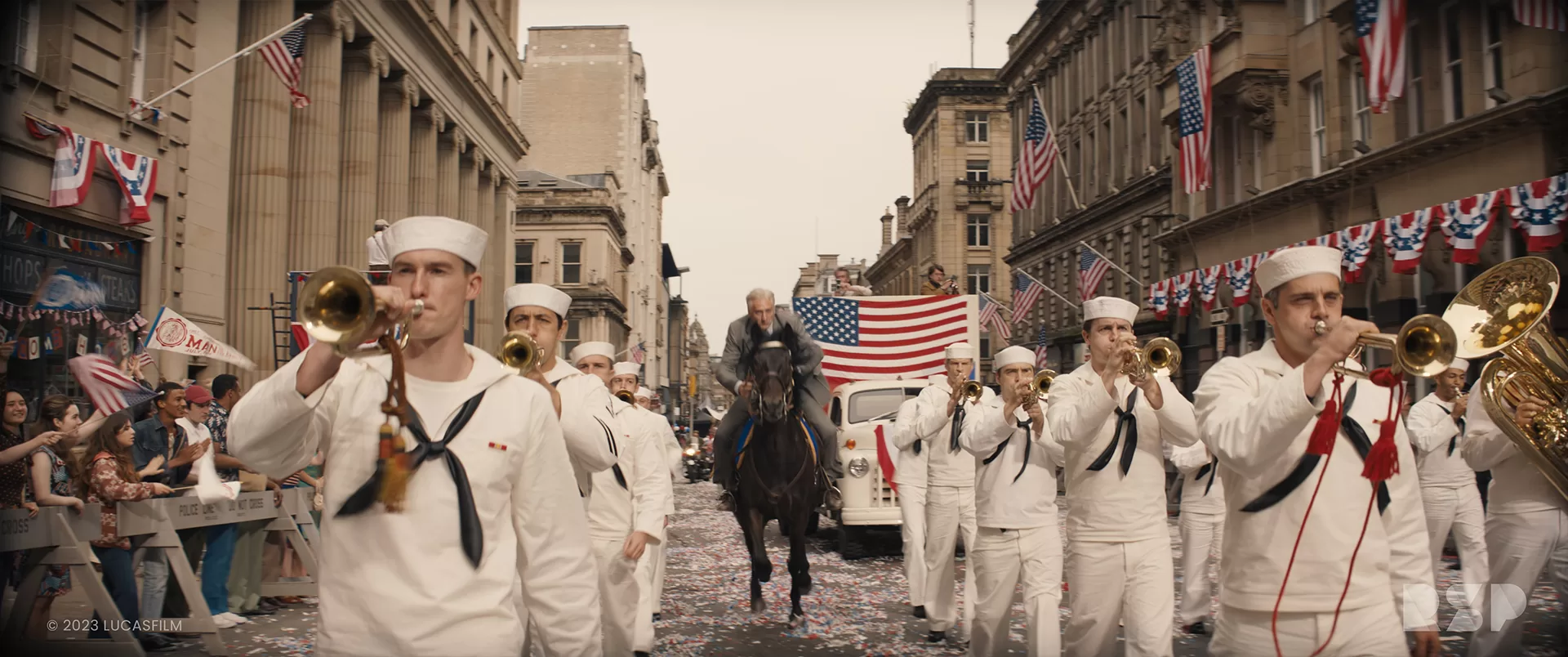
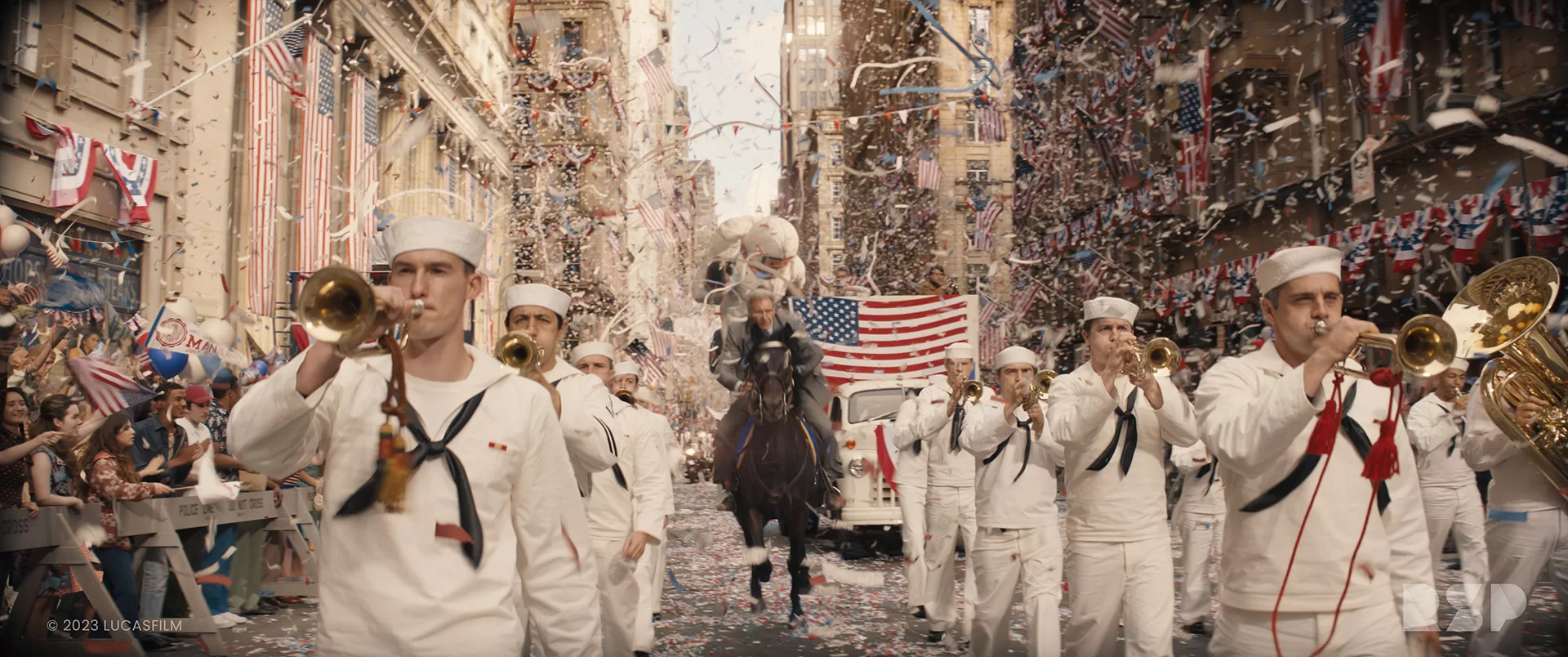
What was the main challenges with this sequence?
New York had a combination of challenges as parts were shot on location in Glasgow for the ticker tape parade whilst others sections were shot on backlot in the UK. This posed many layout/continuity challenges as Indy’s escape and ride through the parade all had to be carefully mapped out to work both for the story and within the world space of our build.
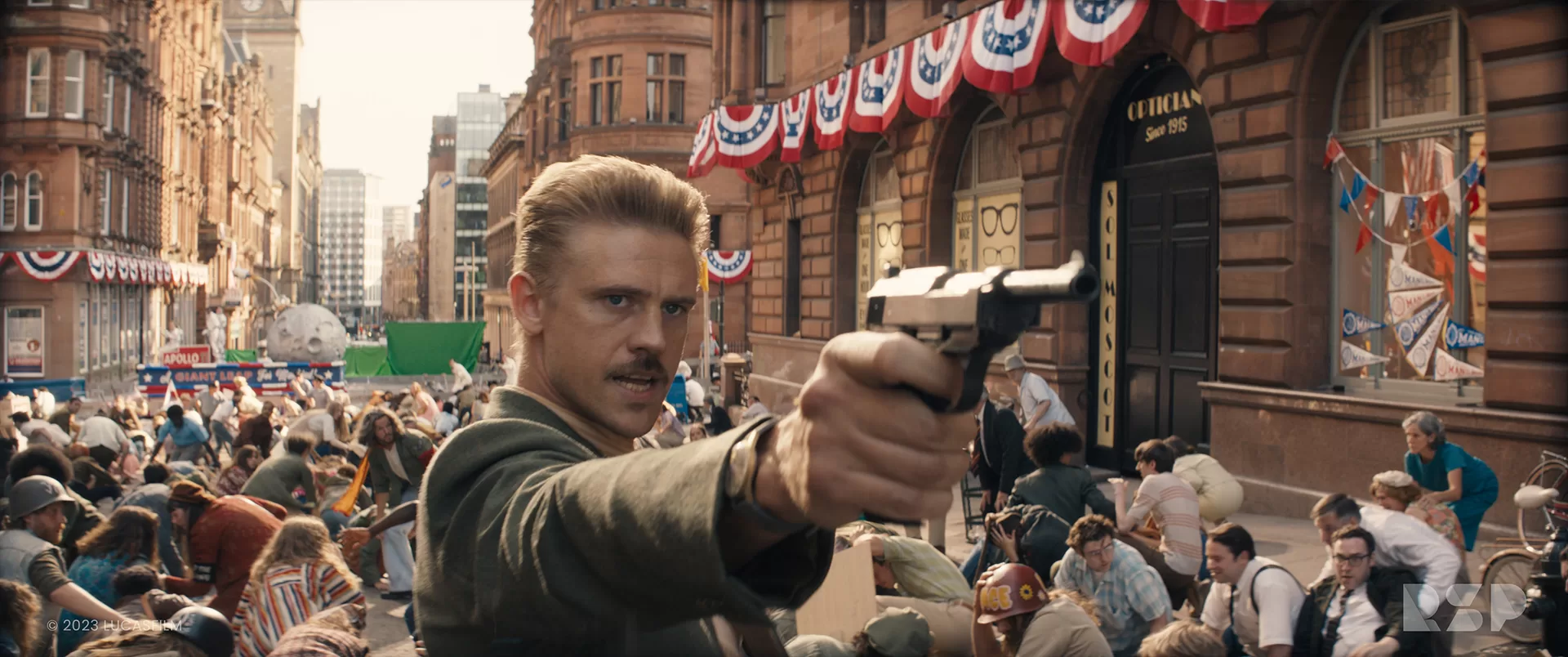
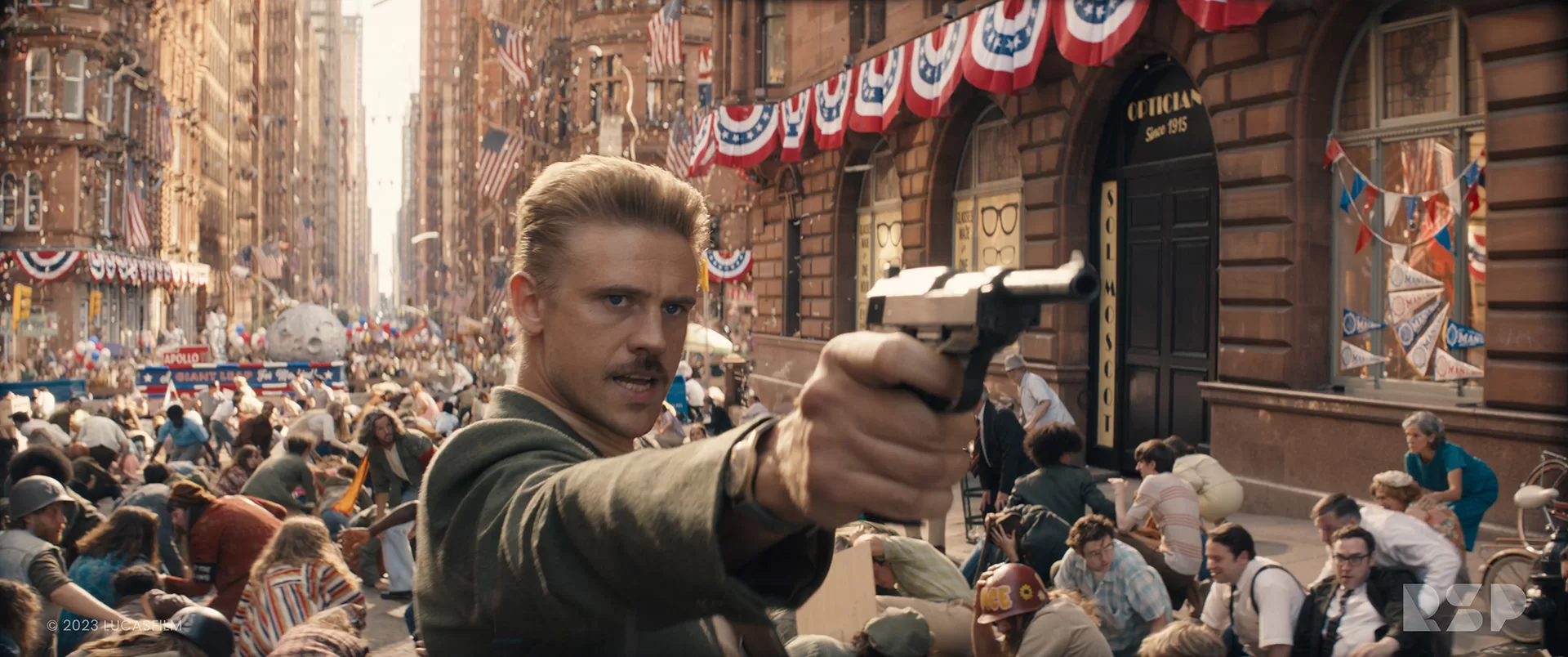
Can you elaborates about your work on the subway chase?
The Subway chase sequence was made from a combination of onset photography shot within the practical station built on set, blue screen stuntwork and full CG shots. The challenge creatively was to choreograph all these elements via layout postviz to add maximum drama and energy to the near escape from both trains within the tunnel. We built a long section of tunnel based on the practical build to stage the drama between Indy and the two trains. We built a hero train carriage and populated it with a packed crowd of commuters.
How did you recreate the Pan American terminal at JFK Airport?
We began with collating period correct reference. A combination of postcards, aerial photography and even stills from a James Bond film to inform our Pan Am structure and surrounding carparks and terminals. The sequence was shot with a very minimal live action set. Only a small portion of tarmac, pillars, extras and cars where in the photography with most of the remaining plate extending to a green screen. We wanted to keep as much of the plate however minimal as possible therefore we modified our accurate pillar spacing to conform to the live set. It was important to bring the interior to life with crowd, luggage and movement. whilst the exterior was alive with moving traffic and planes in flight. We wanted the scene to feel like a bustling New York airport complete with taxis piling up along the on-ramp with their headlights traveling across surfaces and making the lighting dynamic and alive.
Which sequence or shot was the most challenging?
Each sequence provided its own set of challenges and creative problems to solve. The parade sequence for us was probably the most challenging as it contained so many elements and required every department to give it their all. Due to COVID restrictions, on set crowd extras were few in number and widely spaced. Extensive roto was required to isolate the sparse crowd and allow us to fill the gaps with digital spectators. We created a huge library of assets to build for street furniture, cars, floats, crowd, buildings, giant « Macy’s Day » style parade balloons to design in collaboration with the production designer. There was a complicated layout puzzle to piece together the location of digital crowd stands, street dressing, parade extensions and float placement for continuity. Lighting had to be dedicated per-shot to blend seamlessly with the plate yet also provide a distinct character and mood across the sequence. We designed thousands of FX crowd agents, with over a hundred unique motion captured actions, holding props, banners and children on shoulders, some throwing a sea of ticker tape and ribbons which floated down through the scene and interacted with animated vehicles. Following this huge CG build was one of the biggest comp challenges I have seen on a show to combine all these elements and layer them all up to form the final composition.
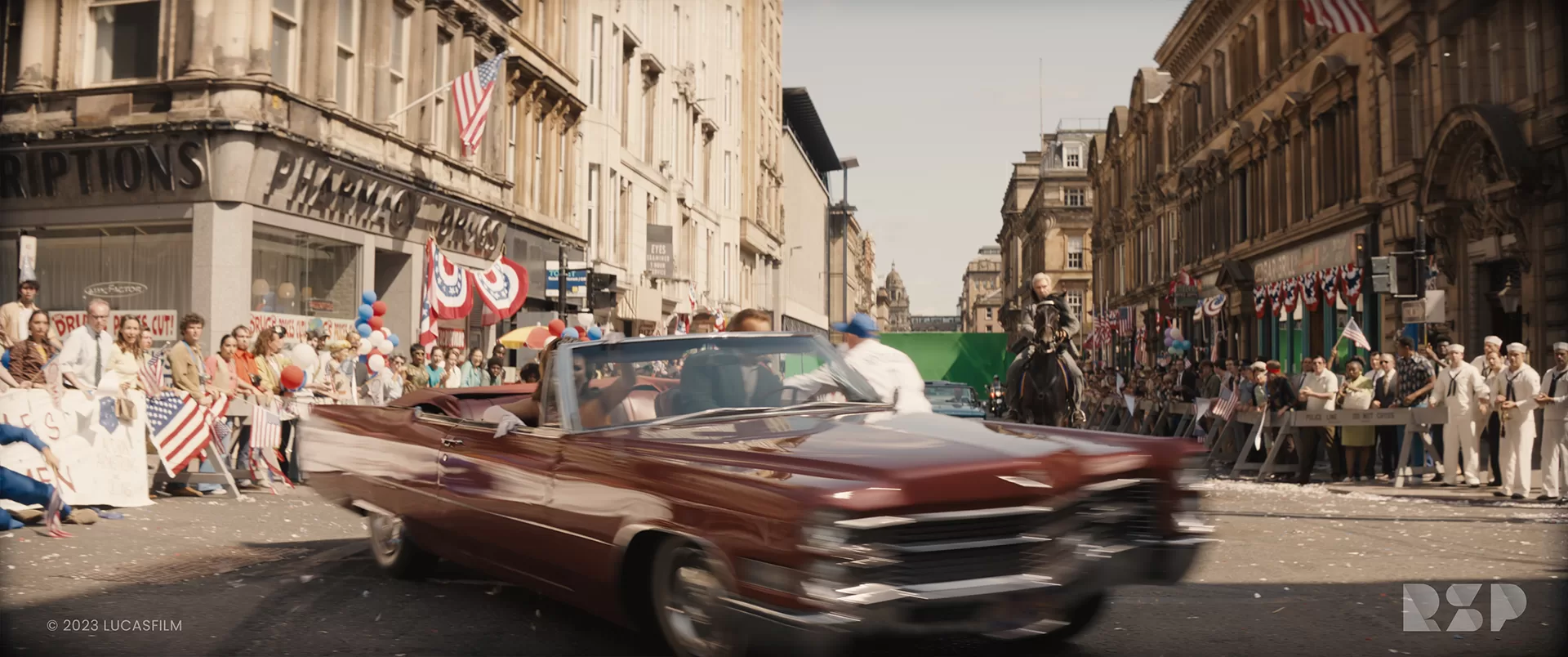
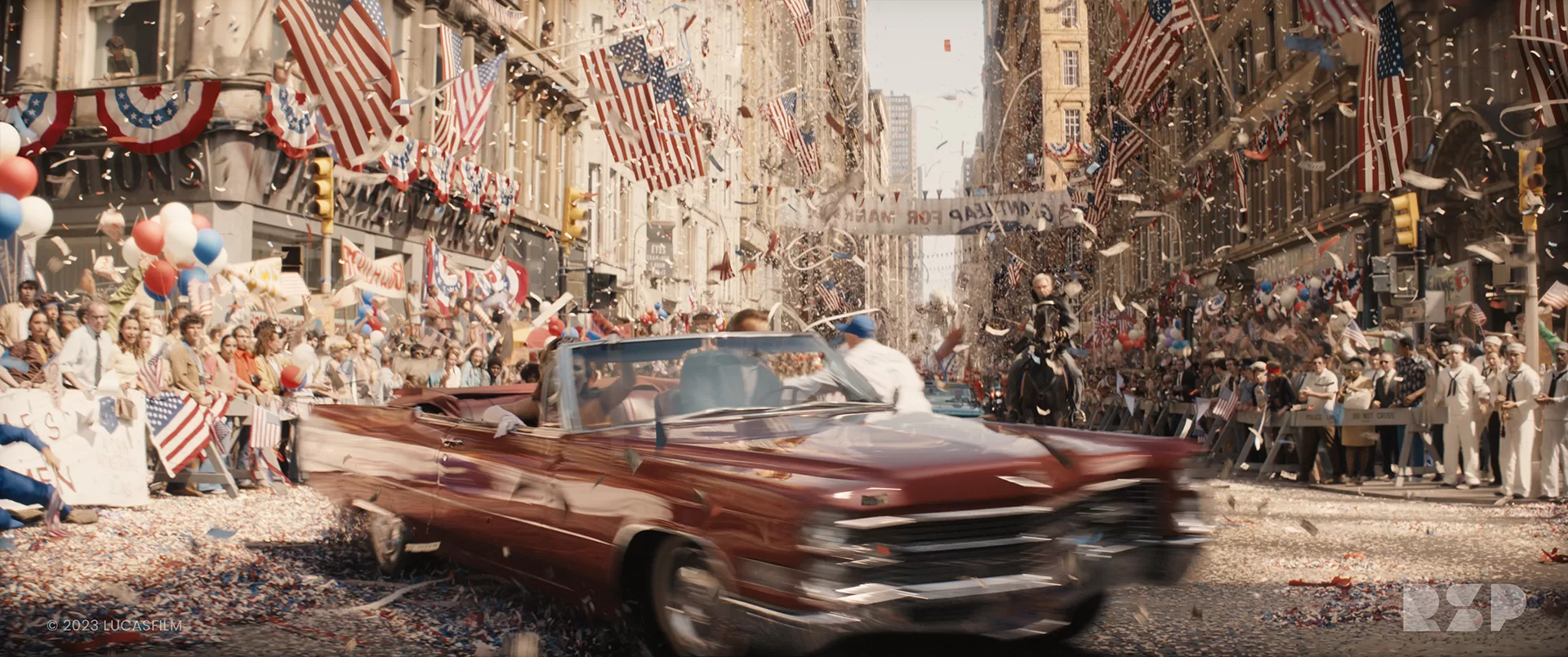
Is there something specific that gives you some really short nights?
When I first looked at the various sequences my initial reaction was, ‘yikes! how are we going to do that crowd?’. There was a very thin layer of extras on set and therefore a much heavier reliance on hero digital crowd extras. Making sure we had enough detail and variation in look, movement and action was the biggest challenge for us. That is one of the things I love about vfx. Starting with ‘how on earth are we going to do this’ and then working together as a team to figure it out.
What is your favorite shot or sequence?
That is a really tough question, I love the airport, subway, rooftop chase and ticker tape parade sequences all for different reasons. One shot does stand out however and that is a shot of Indy from behind galloping past the crowd, soaked in a sea of ticker tape and ribbons lit by a beautiful late afternoon sun. That shot has it all, gorgeous practical lighting, our New York top-ups and street extension, the giant Macy Day style parade balloons we designed with the production designer, people throwing ribbons and ticker-tape from the windows above. A really dramatic iconic shot.
What is your best memory on this show?
When we sat together as a team in the theatre and watched our closing shot of the film with John Williams score fresh of the press. We had been working on that highly complex shot for many months stitching together two non motion-controlled camera moves, one of a Glasgow street on location and another studio shot that ends at Indy’s apartment balcony. To see it all come together accompanied by the iconic music felt like a very special closure to the film and our journey on the project.
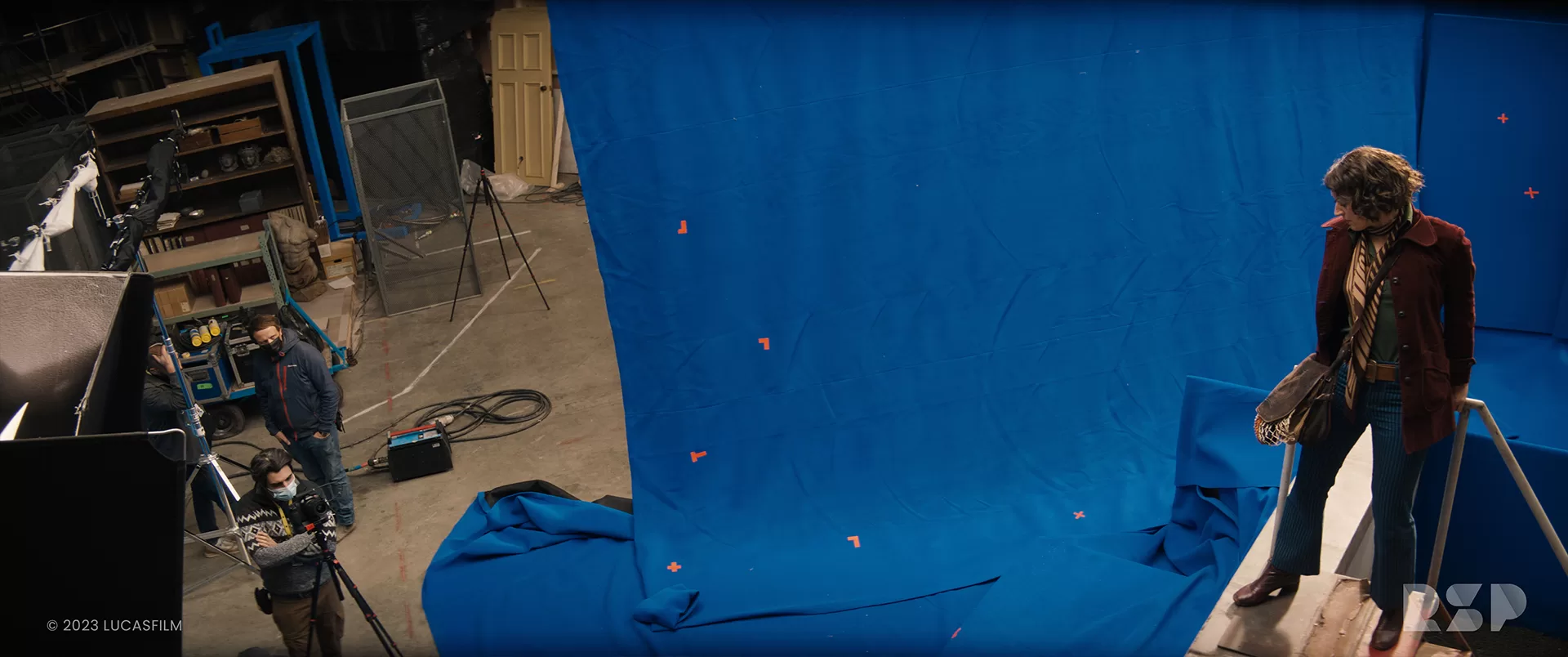
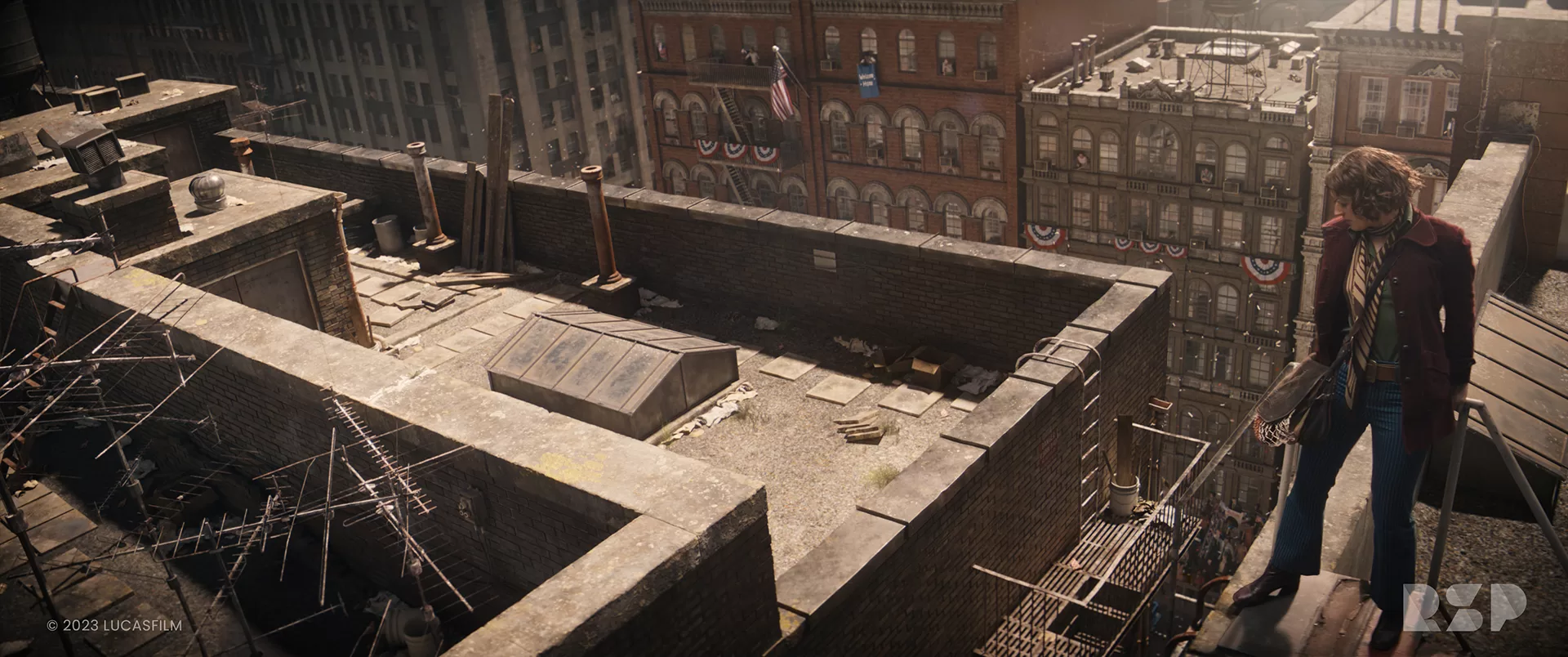
How long have you worked on this show?
Around a year and a half.
What’s the VFX shots count?
Just over 300 shots.
What is your next project?
A new project releasing mid-year, can’t wait to be able to talk about it!
What are the four movies that gave you the passion for cinema?
Labyrinth, Jurassic Park, Once Upon a Time in the West, Amelie.
A big thanks for your time.
WANT TO KNOW MORE?
Rising Sun Pictures: Dedicated page about Indiana Jones and The Dial of Destiny on Rising Sun Pictures website.
© Vincent Frei – The Art of VFX – 2024







